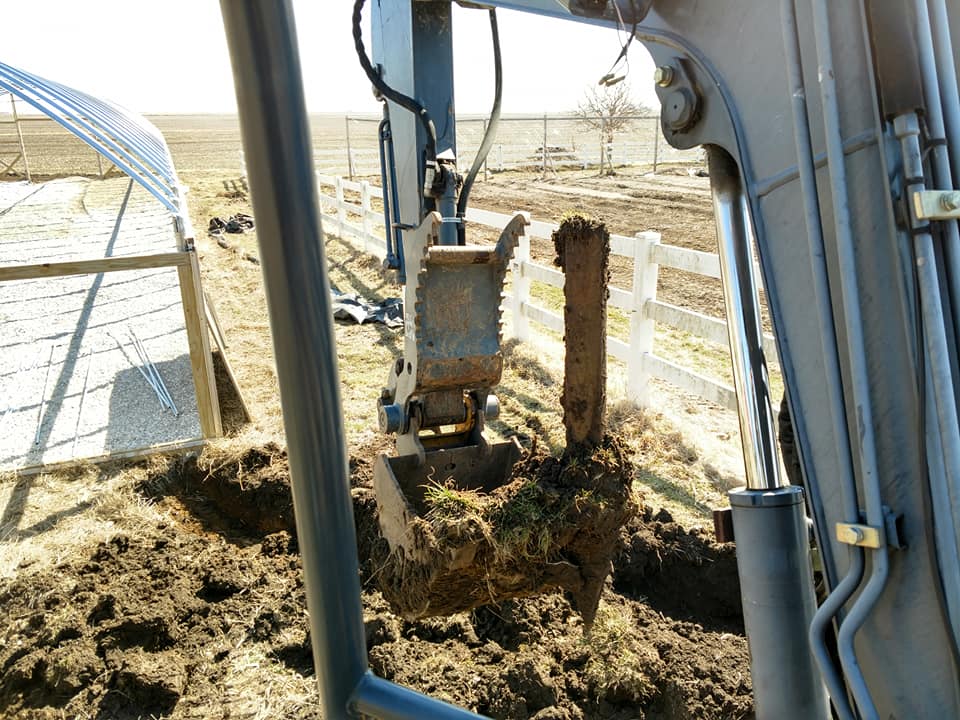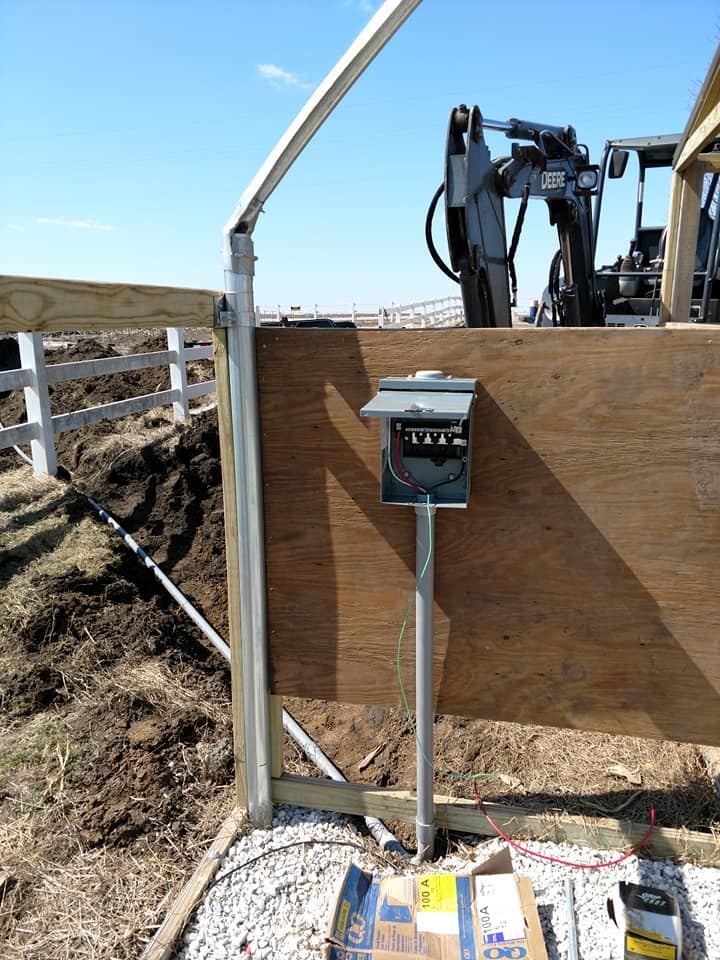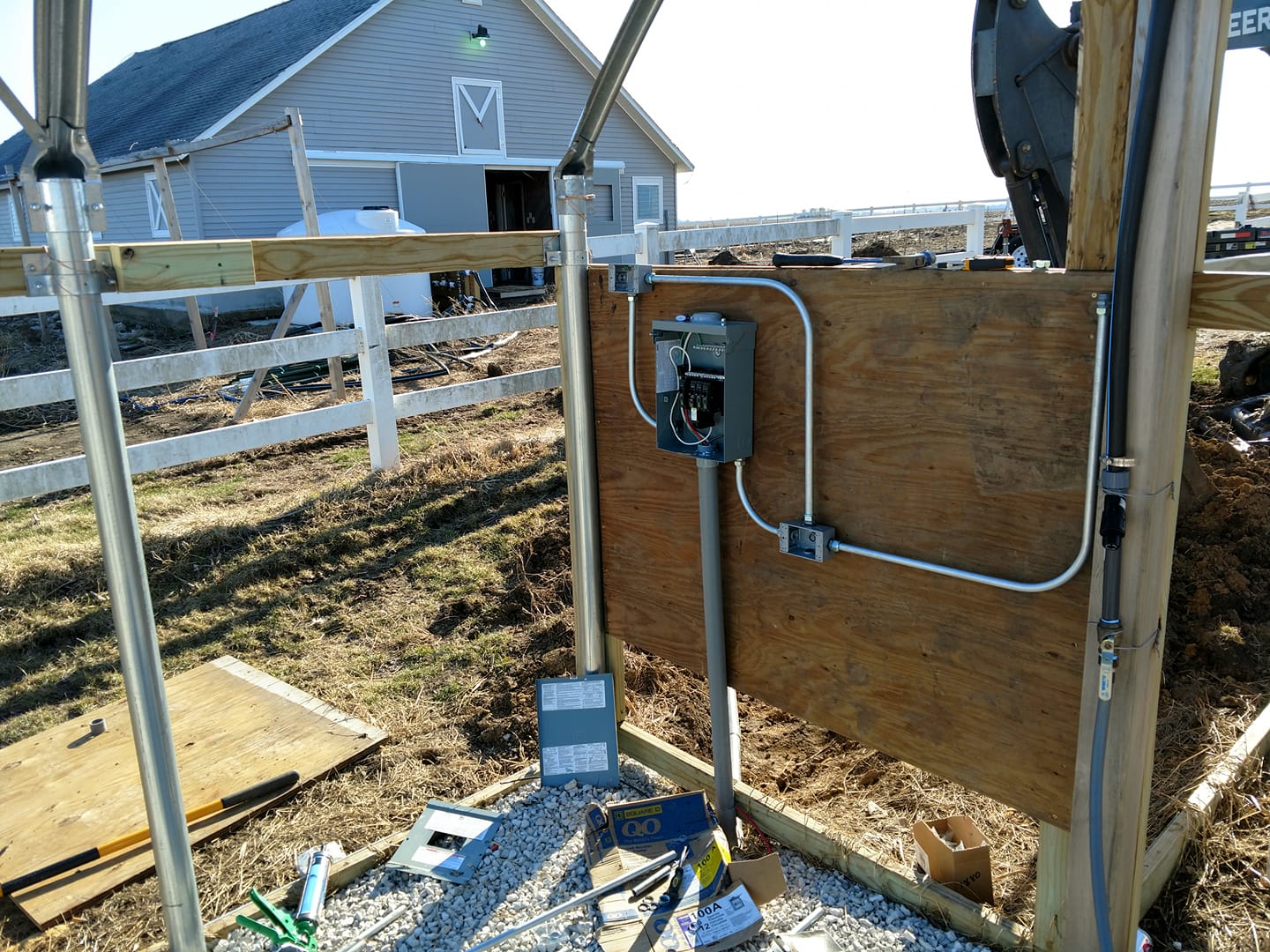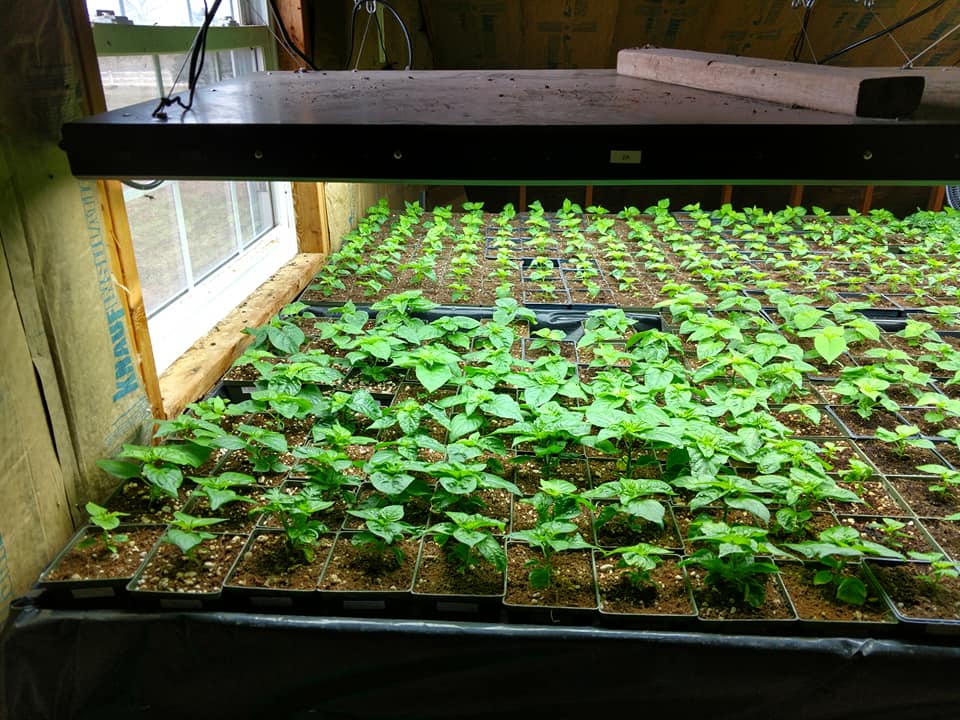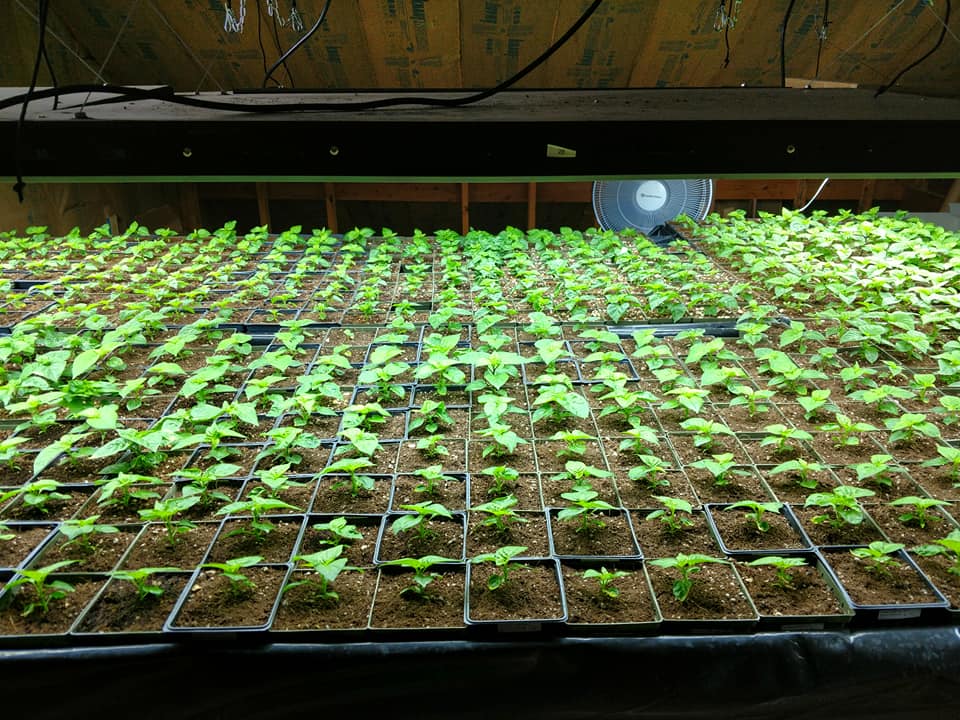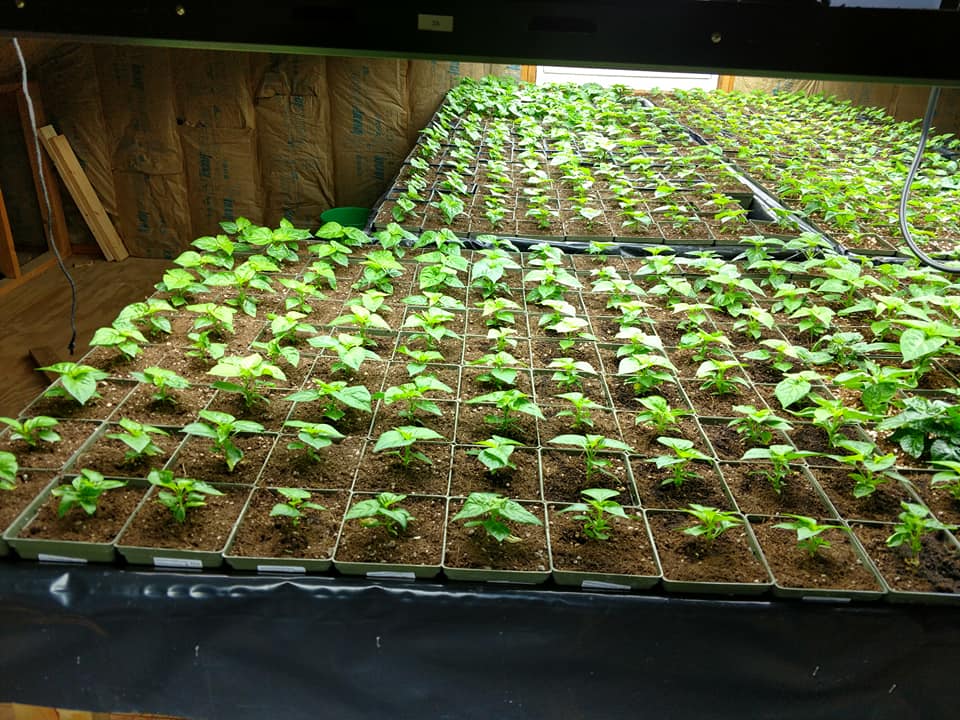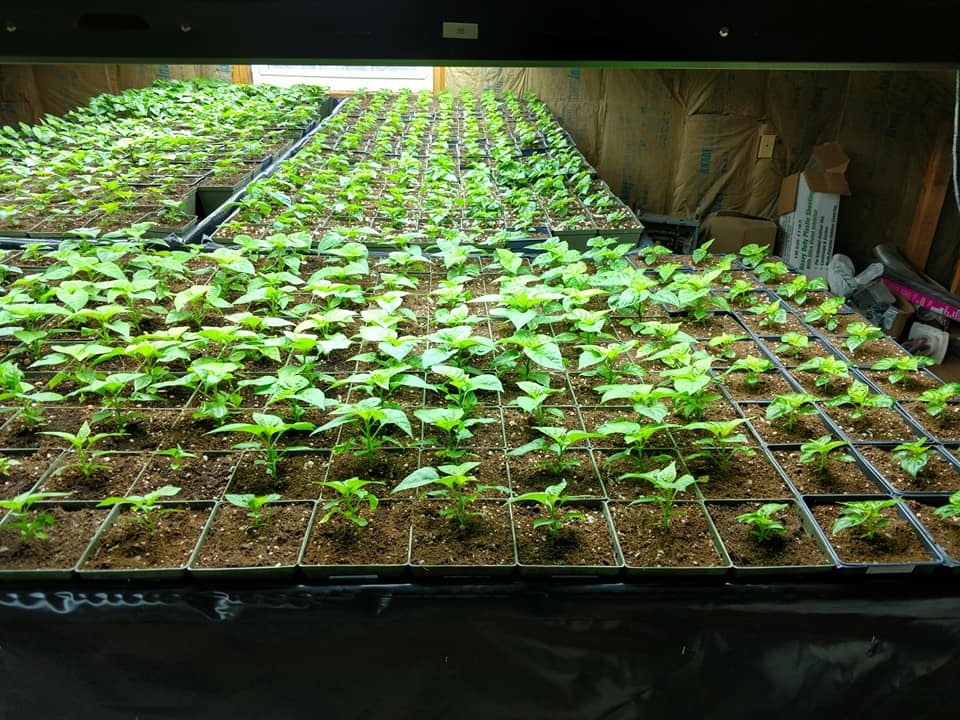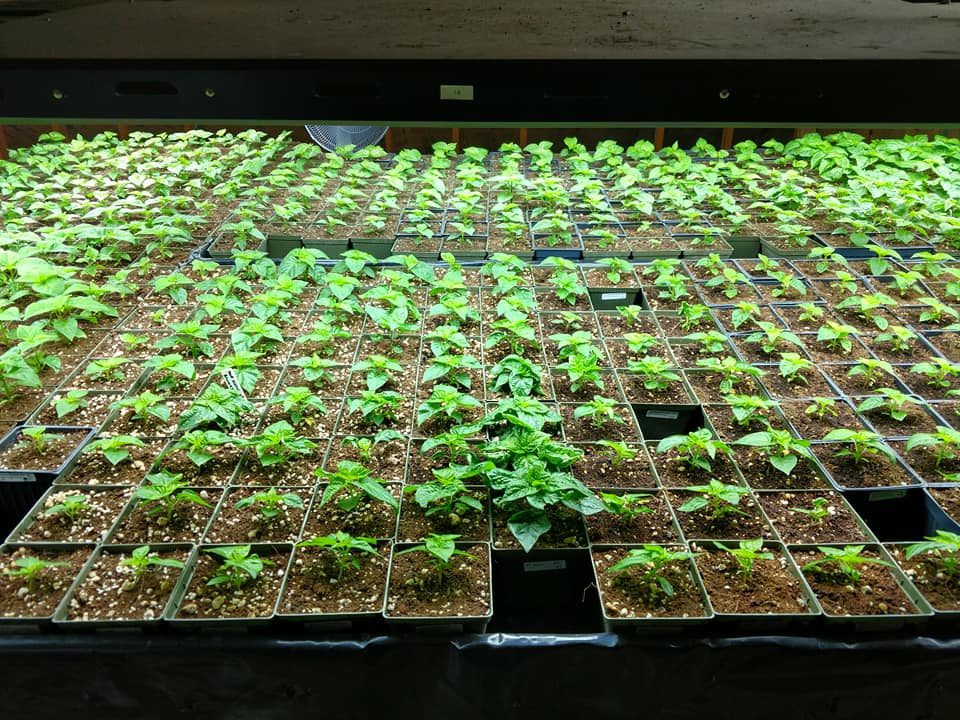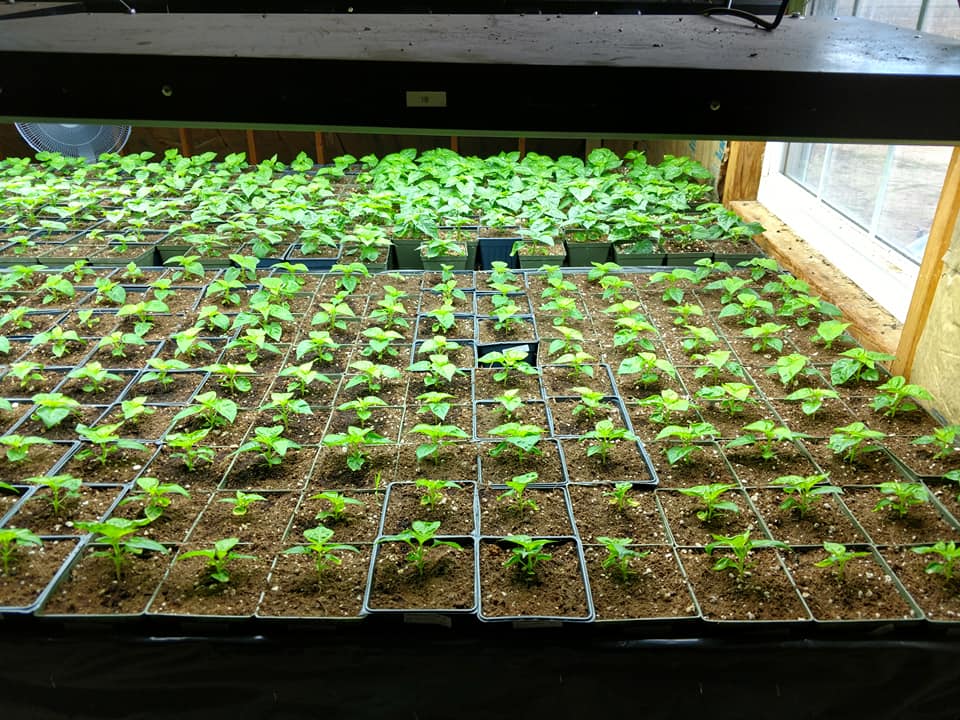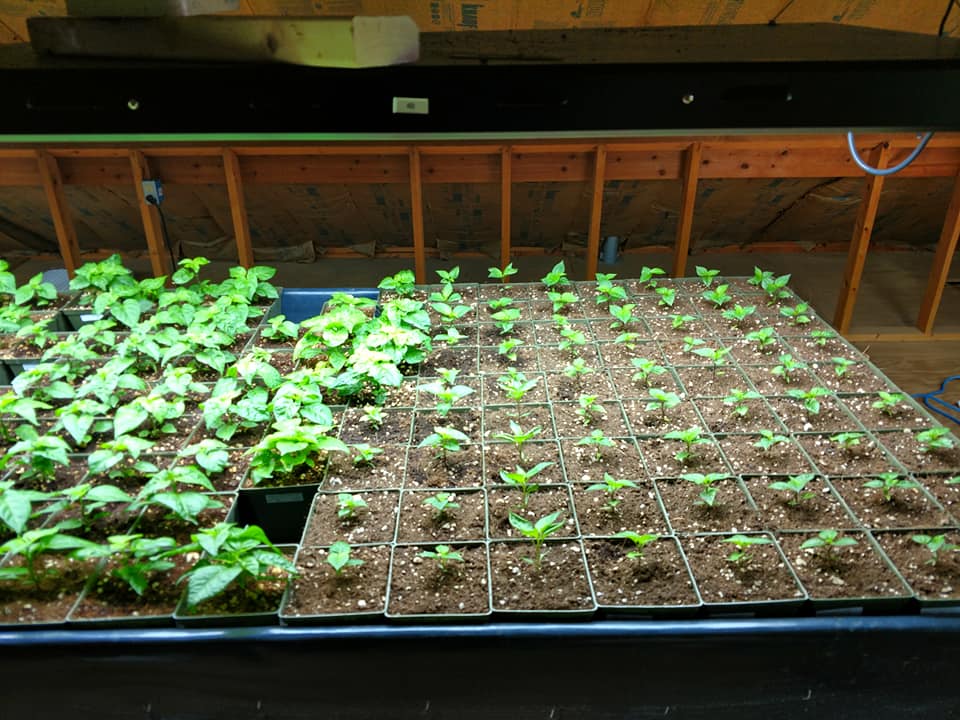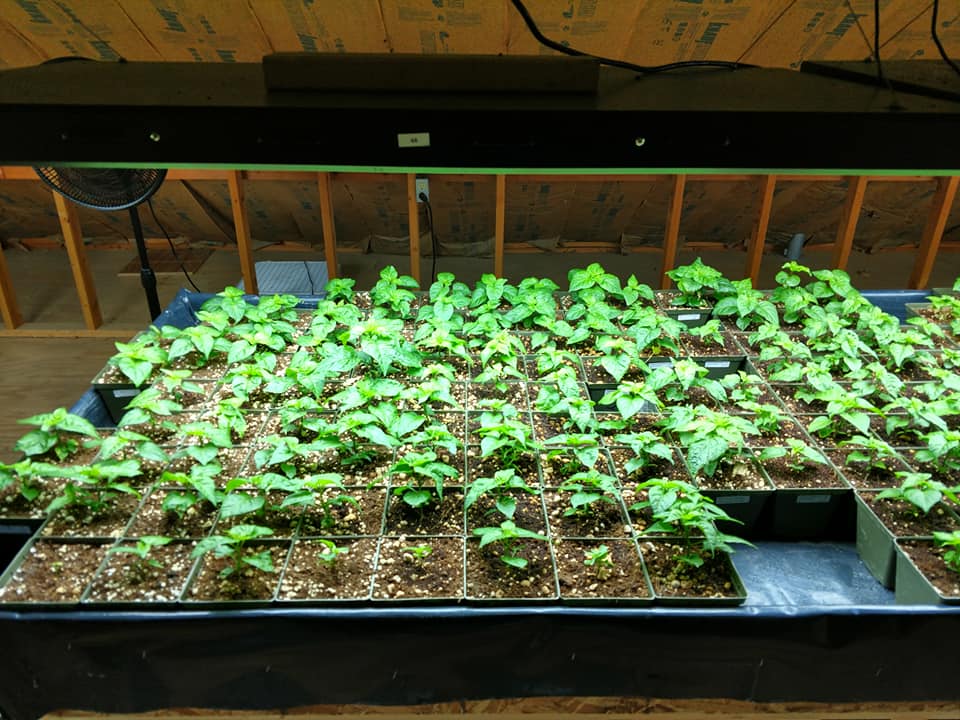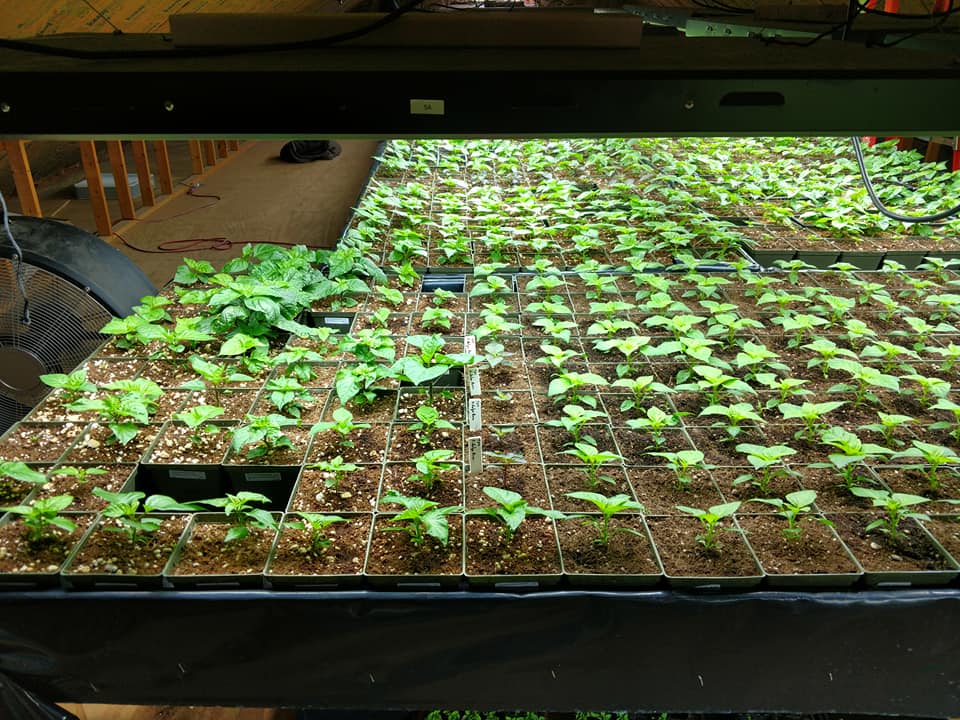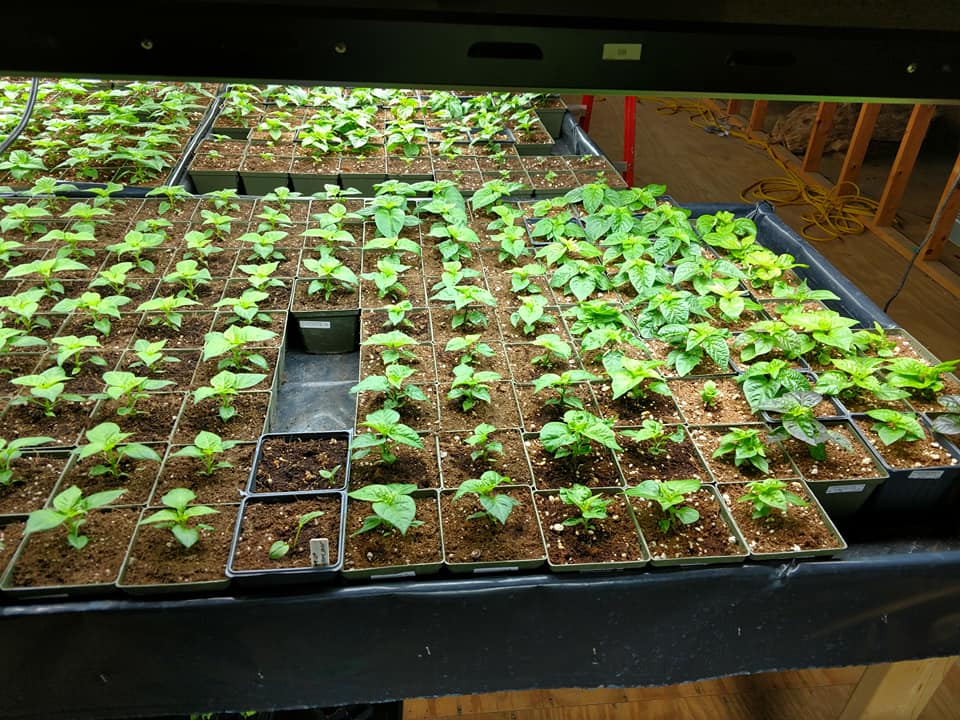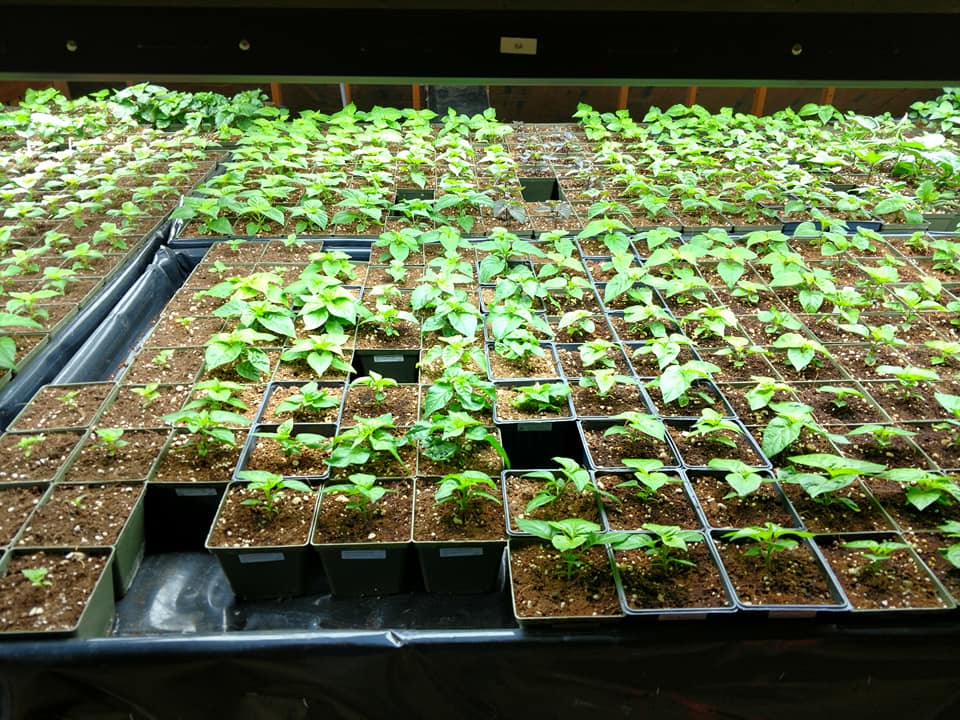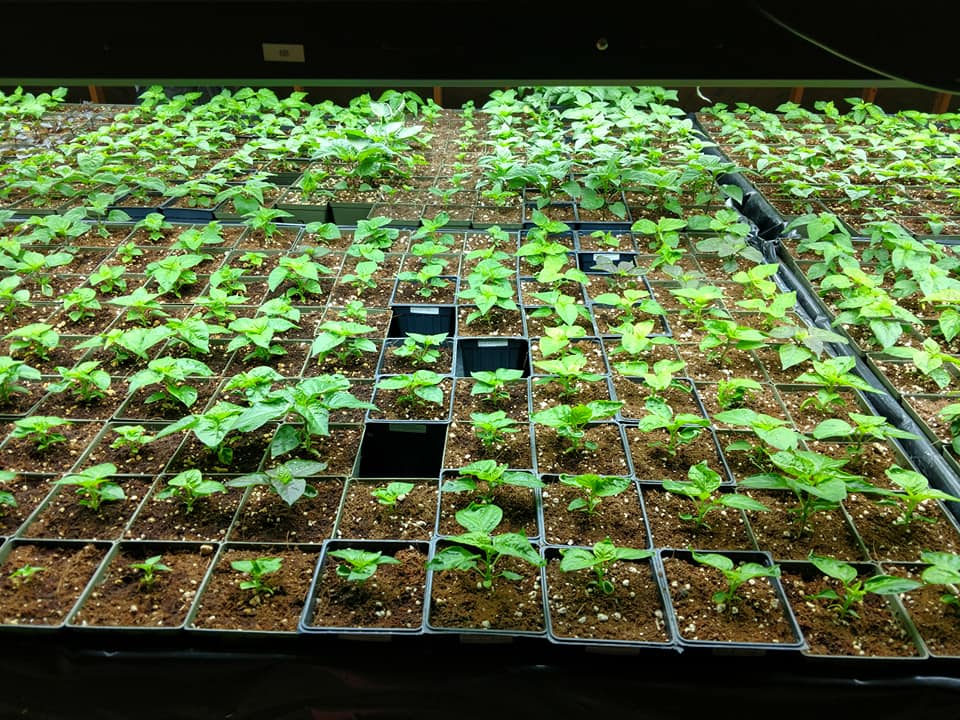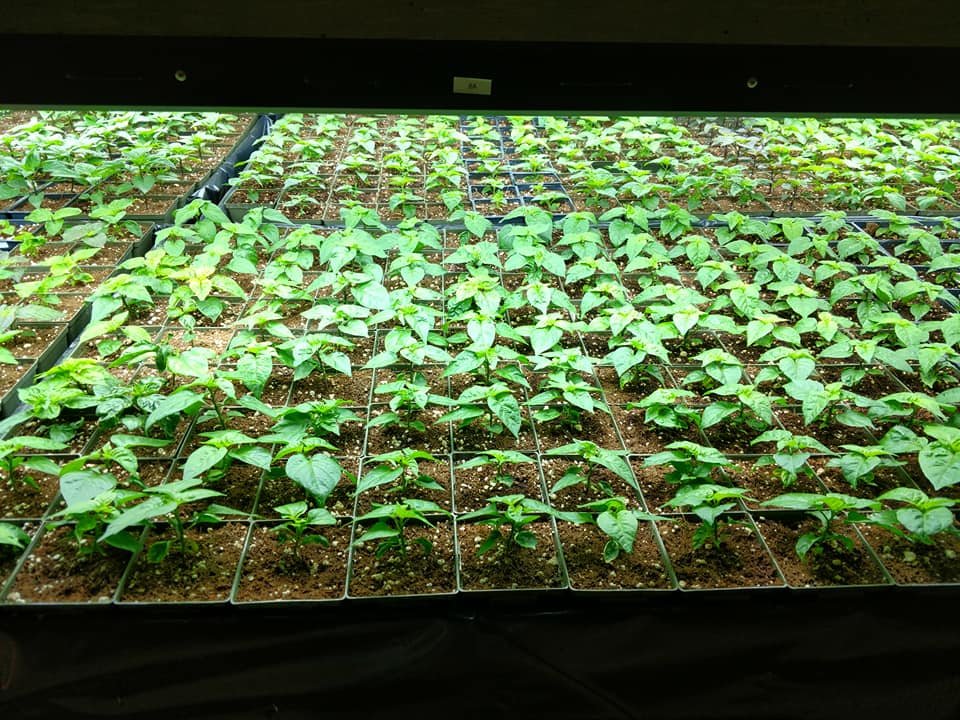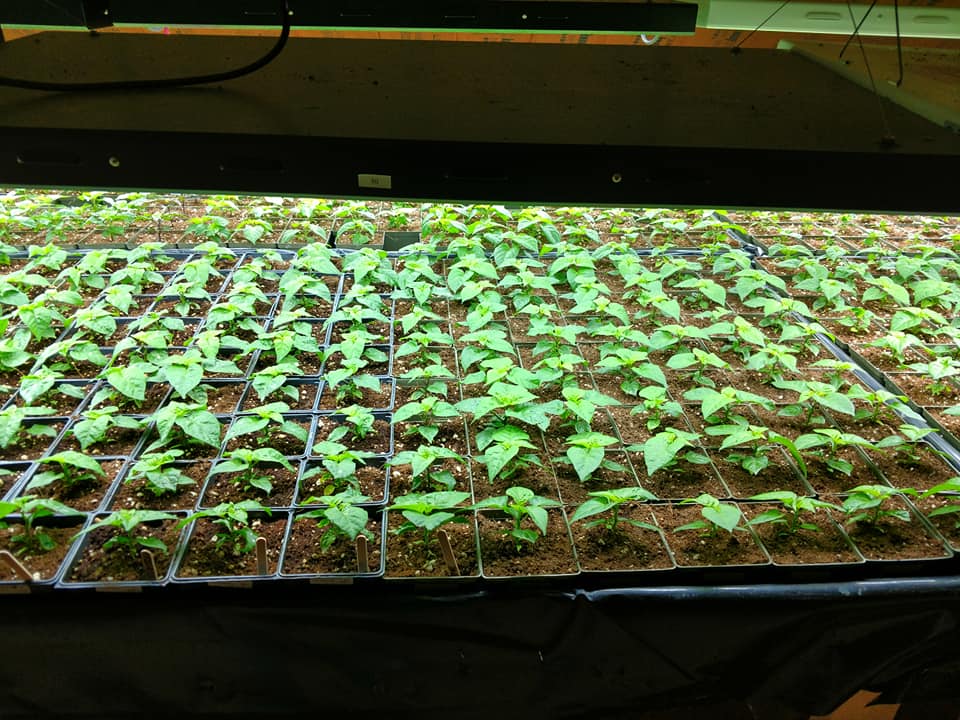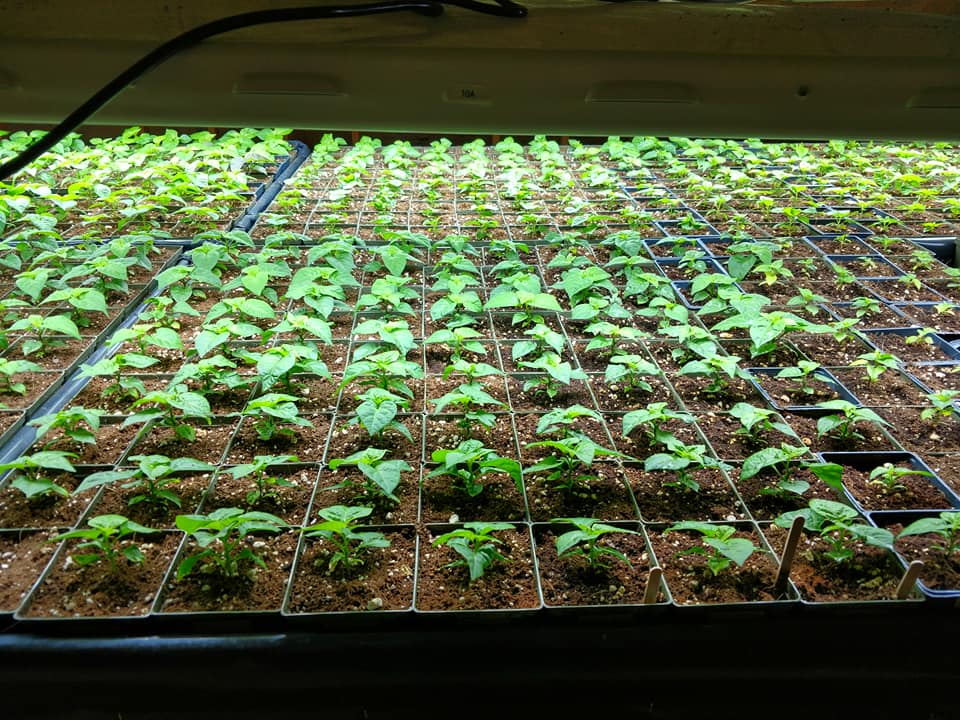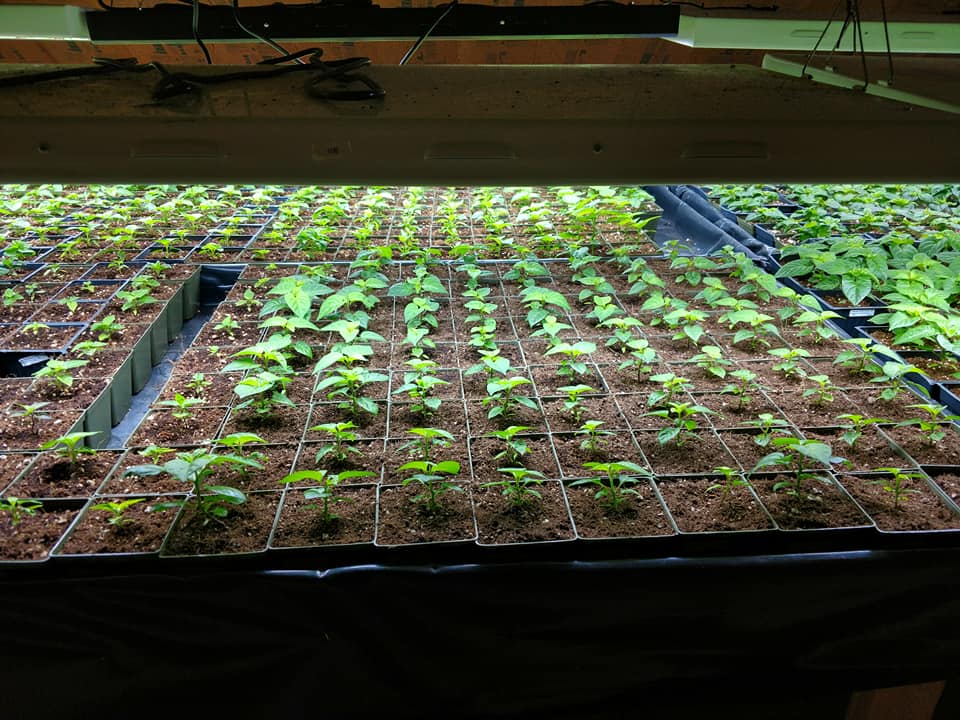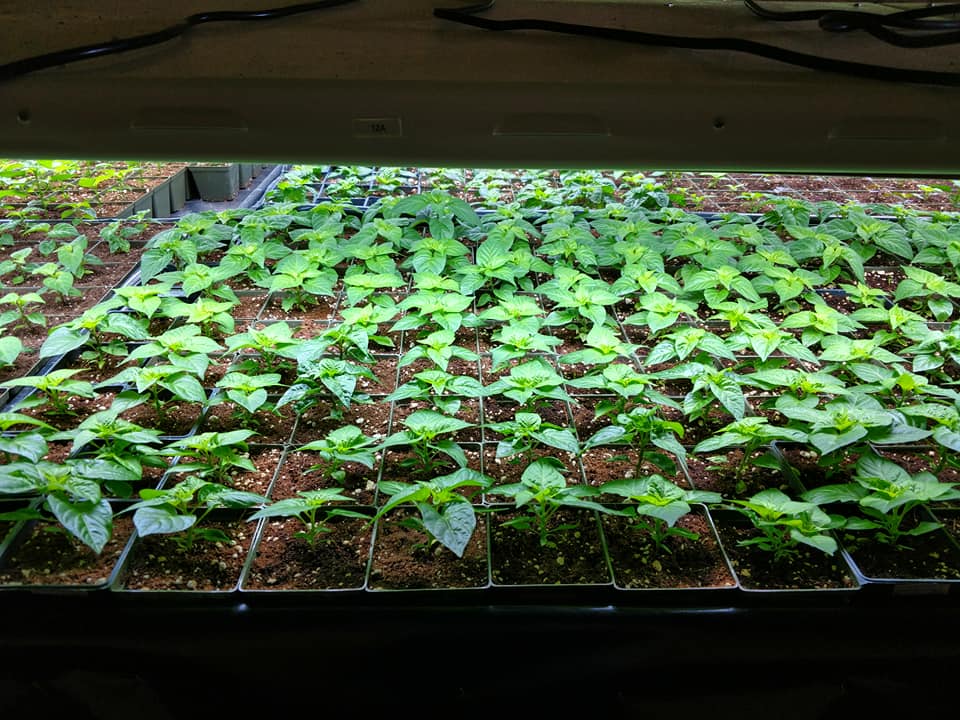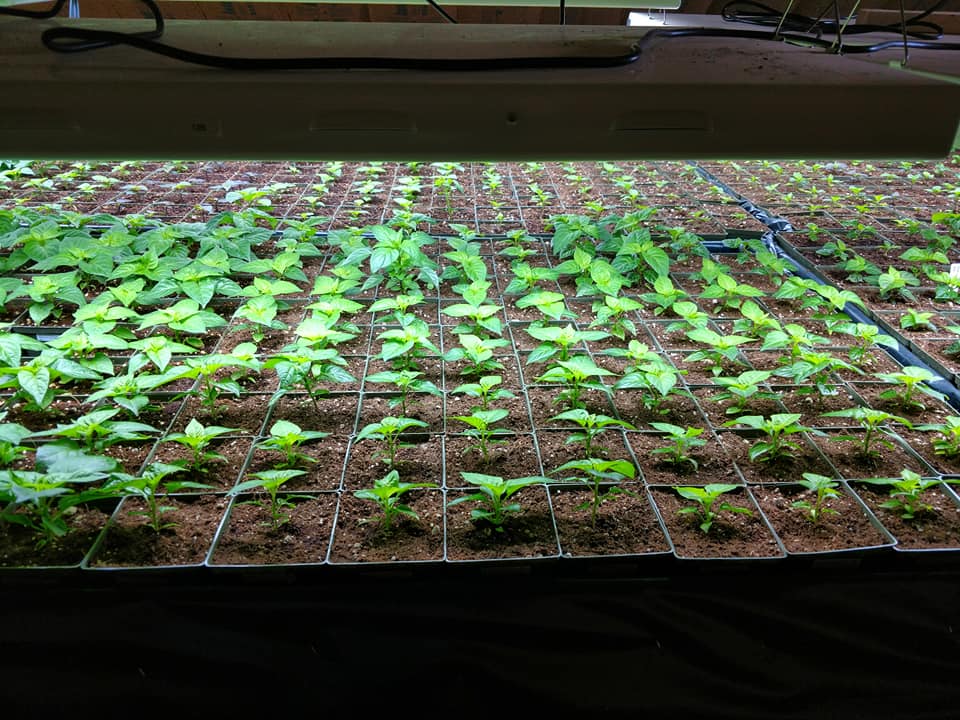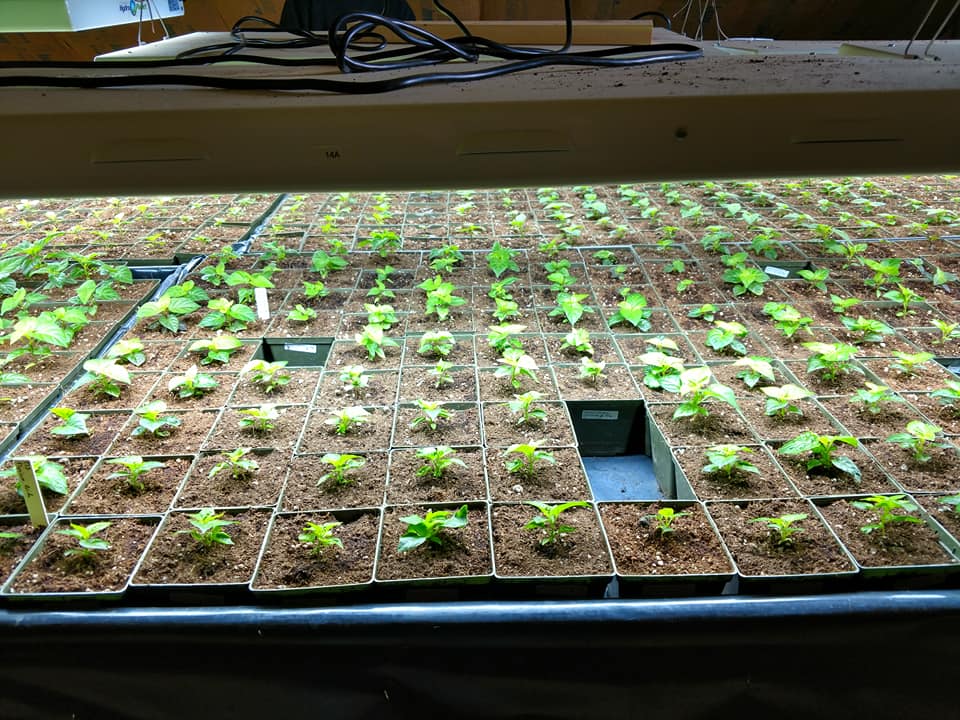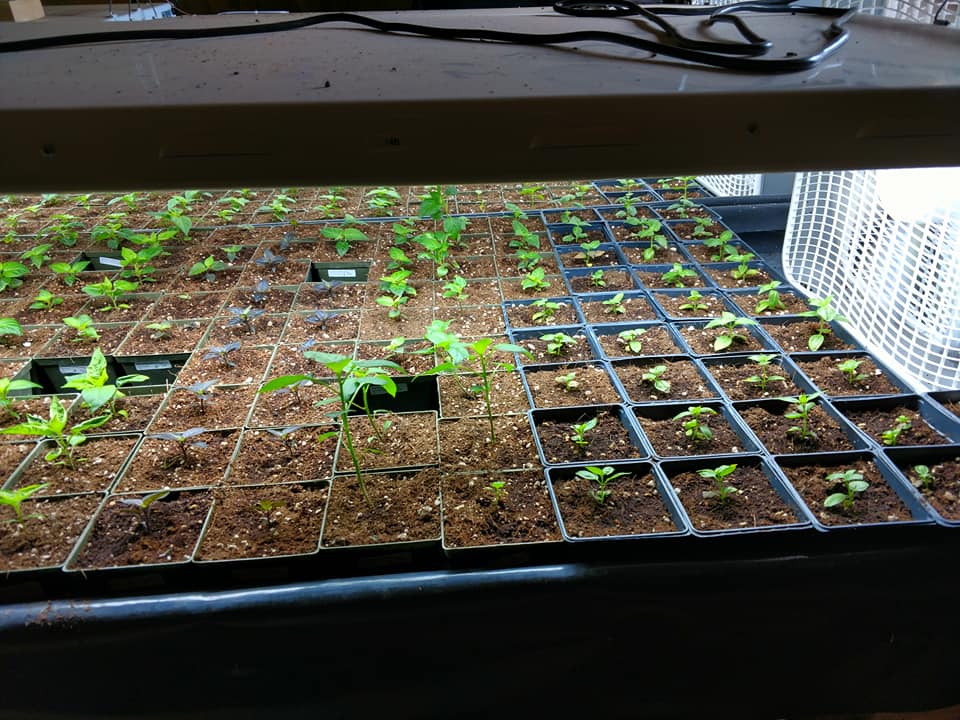Well, it's finally time to start. Again. 
Finished taking inventory of seeds today, and started the 2019 grow list. Since the 24x96' isolation high tunnel is done, I'll be growing a crazy long list this year, as we'll be growing for 2020 seed inventory. With the soil mix equipment, it should be a lot less work on my back this winter! (Even more so if I get the indoor grow areas plumbed and set up on drip irrigation, still not sure I got the budget for that yet tho)
Some of the seeds I'll be pulling from are damn near 10 years old now, so I expect many of these to eventually get crossed off with 0 germination. Everything I have ever saved or traded is getting planted, though. There's 203 on the list right now, many duplicates though where seeds were sourced from more than one person/vendor.
The grow room at home is getting a makeover, going to be "going vertical" to get some space back. More on that in a few days...
This list is not complete yet, I will be adding more after I hear back from a few folks I PM'd.
7 Pot Chaguanas Red (BE)
7 Pot Chaguanas Red (PL)
7 Pot Jonah (PL)
7 Pot Long (PL)
7 Pot Original Red
7 Pot Primo Red
7-Pot Brainstrain (LFF)
7-Pot Brainstrain Red
7-Pot Brainstrain Red (PL)
7-Pot Brainstrain Yellow (PL)
7-Pot Primo (LFF)
7-pot Primo Red
Aji Amarillo
Aji Cereza
Aji Dulce Red
Aji Golden
Aji Golden (old)
Aji Golden (LFF)
Aji Jobito
Aji Limo
Aji Limo (LFF)
Aji Margaritereivo
Aji Peruvian
Aleppo (BE)
Aleppo (LFF)
Amish Bush
Bahamian Goat
Bahamian Goat (old)
Barre Do Robiero
Bhut (Walchits)
Bhut Jolokia Brown
Bhut Jolokia Chocolate
Bhut Jolokia Indian Carbon
Bhut Jolokia Red
Bhut Jolokia Yellow
Big Sun Habanero
Big Sun Habanero (LFF)
Big Thai Hybrid
Biker Billy (AJ Drew)
Biker Billy Jalapeno (LFF)
Black Habanero
BOC
Bolsa De Dulce
Bonda Ma Jacques
Boyanska Kapiya
Brazilian Starfish
Brown Bhut Jolokia (LFF)
Brown Moruga
Brown Moruga (PL)
Bulgarian Carrot
CAP 215
Carbaruga Yellow
Caribbean Red Hab
Carmia Sweet
Carolina Reaper (PL)
Carolina Reaper (BE)
Carolina Reaper (LFF)
Carribean Red Habanero (very old)
Cayenne Long Red
CGN 19198
CGN 20812
CGN 22091
CGN 22792
CGN 24360
Chapeu Du Frade
Chapeu Du Frade (LFF)
Cherry Red
Chili
Chili de Abrol
Chocolate Bhutlah
Chocolate Naga Morich
Chocolate Scotch Bonnet
Criolla Sella
Criolla Sella (WHP)
Cubanelle
Datil
Dedo de Moca
Dorset Naga (BE)
Dorset Naga (PL)
Dragon Cayenne
Dragon Cayenne (most likely crossed?)
Drying Serrano
Dulce Sol
Elephant Trunk
Espanola
Farmers Jalapeno
Farmers Jalapeno (LFF)
Farmers Market Jalapeno
Fidalgo Roxa
Freeport Orange Scotch Bonnet
Fresno (BE)
Fresno Red
Friarello Di Napoli
Friarieilo Di Napoli
Garden Salsa
Giant Aconcagua
Giant Mexican Rocoto
Goat Pepper
Goats Weed
Habanero Antillais Caribbean
Habanero Chocolate (PL)
Habanero Cristiana
Habanero Franciscon
Habanero Giant Orange
Habanero Guadalupe
Habanero Magnum Orange
Habanero Manzano
Habanero Niranja Picante
Habenero Red Dominica
Harbiye
Hawaiian Kona
Hot Paper Lantern
Jalapeno Biker Billy
Jigsaw
Land Race Serrano
Large Orange Thai
Large Red 7 Pot (PL)
Large Red Rocoto
Mako Akokosrade
Mako Kokoo
Matay
Matay (PL)
Mini Bell Orange
MOA Scotch Bonnet
MOA Scotch Bonnet (very old)
MOA Scotch Bonnet (LFF)
Monster Naga
Moruga Reaper
Moruga Scorpion (LFF)
Moruga x Reaper (LFF)
Ms. Junie
Naga Morich
NuMex Lemon Spice Jalapeno
Numex Pinata Jalapeno
NuMex Vaquero
Orange Habanero (Wicked Mike)
Orchid PI 497974
P. Dreadie
Paper Lantern Habanero
pI 281429
Pimenta Chris Fat
Pimenta de Neyde (PL)
Pimente Espellette
Pimente Espellette (old)
Pimiento Cristal (LFF)
Poblano (old)
Poblano BE
Poblano (LFF)
Purple Jalapeno x Cayenne
Purple UFO
Reaper (Walchit)
Reaper Bhut
Red Fatalli (LFF)
Safi Scotch Bonnet
Santa Fe Grande
Santa Fe Grande (PJ)
Santa Fe Grande Peppers
Scoda Brain
Scotch Bonnet x Bell Pepper
Shattah
Star of Turkey
Stuffing Cherry
Sugar Cane
Sweet Anaheim
Sweet Anaheim (LFF)
Sweet Charleston
Sweet Charlston (LFF)
Sweet Datil (old)
Sweet French Bell
Tangerine
Tekne Dolmasi
Tekne Dolmasi (LFF)
TFM Scotch Bonnet
TFM Scotch Bonnet (LFF)
Thai
Thai (crossed?)
Thai Orange
Thai Short
Tobago Scotch Bonnet Red (PL)
Tobago Scotch Bonnet Yellow
Tobago Seasoning
Trinidad Doughlah
Trinidad Perfume
Trinidad PI 281317
Trinidad Scorpion Butch T
Trinidad Scorpion Cardi
Trinidad Scorpion Moruga
Trinidad Scorpion Original
Trinidad Scorpion Smooth
Trinidad Scorpion Yellow
Trinidad X
True Cumari
Turkish Cayenne (LFF)
Turkish Sweet Ball
Urfa Biber
White Bhut Jolokia
White Bullet Habanero
White Habanero
Xalapas Large Jalapeno
Yellow Brainstrain (LFF)
Yellow Fatalli
Yellow Moruga Scorpion
Yellow Scotch Bonnet (old)
Added 1/16, ordered from Justin
7 Pot Brain Strain Chocolate AU
7 Pot Bubblegum (BBG7) Bhut Chocolate
7 Pot Bubblegum (BBG7) x Apocalypse Scorpion (No Calyx)
7 Pot Cinder F3
7 Pot Douglah
7 Pot Jonah
7 Pot Jonah Yellow X SB
7 Pot Lucy
7 Pot Nebru
7 Pot Primo Chocolate
7 Pot SR Strain
7JPN
Aji Pineapple
Apocalypse Scorpion Chocolate
Bahamian Beast Mustard Stinger F2
Bahamian Goat
Bhut Jolokia (Ghost) Giant Chocolate
Bhut Jolokia (Ghost) Rust
Bhut Jolokia (Ghost) Solid Gold
Black Pearl
Brazilian Brain Strain Chocolate
Brown Reaper Cross
Devil's Nagabrains Chocolate
Elysium Oxide Scotch Bonnet
Fatalii Chocolate
Genghis Kahn's Brain
Habanero El Remo
Habanero Roatan Pumpkin
Jigsaw x Moruga
Jonah's Yellow Brain
Machu Picchu
Mako Akokosrade
Monkey Face Red
Nagabrains Chocolate
Negro de Valle
Pimenta Black Bhut
Sandra's Giant Orange (Long Pheno)
SB7J Yellow
Scotch Bonnet Sweet Moruga Brown
Scotch Brains (7 Pot Pheno)
Skunk Chocolate
Tepin x Lemon Drop
UBSC x SB
Vallero
WHP 027
Should have the first of the chinense and pube seeds in the dirt by end of week.
Non-pepper crop
Anise Hyssop
Astro Arugula (Roquette)
Esmee Arugula (Roquette)
Arugula (Standard)
Sylvetta Arugula (Roquette)
Mizuna Asian Greens
Tatsoi Asian Greens
Red Rubin Purple Basil
Sweet Thai Asian Basil
Genovese Genovese Basil
Aroma 2 Genovese Basil
Royal Burgundy Beans
EZ Pick Beans
Tongue of Fire Beans
Prime Ark® Freedom Blackberry
Blueberry Plant Collection Blueberry
De Cicco Standard Broccoli
Belstar Standard Broccoli
Chiko Burdock
Integro Fresh Market Cabbage
Red Express Fresh Market Cabbage
Farao Fresh Market Cabbage
Deadon Fresh Market Cabbage
Bilko Chinese Cabbage
Divergent Cantaloupe (Muskmelon)
Nectar Main Crop Carrots
Negovia Carrot
Nectar Main Crop Carrots
Negovia Main Crop Carrots
Napoli Early Carrots
Yaya Early Carrots
Yaya Early Carrots
Janvel Standard Cauliflower
Mardi Standard Cauliflower
Mardi Standard Cauliflower
Janvel Standard Cauliflower
Veronica Romanesco Cauliflower
Skywalker Standard Cauliflower
Skywalker Standard Cauliflower
Common Chamomile Chamomile
Staro Standard Chives
Nira Chinese Leeks (Garlic Chives)
Cheyenne Spirit Echinacea (Coneflower)
Echinacea purpurea Echinacea (Coneflower)
Leisure Cilantro (Coriander)
Santo Cilantro (Coriander)
Natural Sweet Sweet Corn
Enchanted Sweet Corn
Nothstine Dent Dry Corn
Xtra-Tender 2171 Sweet Corn
Cressida Cress
Cool Customer Pickling Cucumbers
Poniente Seedless and Thin-skinned Cucumbers
Picolino Slicing Cucumbers
Hera Dill
Bouquet Dill
Totem Belgian Endive (Witloof)
Ruby Red Orach Specialty Greens
Light Green Orach Specialty Greens
Dark Green Orach Specialty Greens
Red Russian Kale
Toscano Kale
Westlandse Winter Kale
Toscano Kale
Red Russian Kale
Korist Fresh Eating Kohlrabi
Azur Star Kohlrabi
Kossak Storage Kohlrabi
Munstead-Type Lavender
Megaton Leeks
King Richard Leeks
Pandora Leeks
Lemon Balm
Celinet Summer Crisp Lettuce (Batavia)
Concept Summer Crisp Lettuce (Batavia)
Muir Summer Crisp Lettuce (Batavia)
Alkindus Butterhead Lettuce (Boston)
Mirlo Butterhead Lettuce (Boston)
Red Cross Butterhead Lettuce (Boston)
Sylvesta Butterhead Lettuce (Boston)
Annapolis Romaine Lettuce (Cos)
Breen Romaine Lettuce (Cos)
Coastal Star Romaine Lettuce (Cos)
Defender Romaine Lettuce (Cos)
Dragoon Romaine Lettuce (Cos)
Ezbruke Romaine Lettuce (Cos)
Flashy Trout Back Romaine Lettuce (Cos)
Fusion Romaine Lettuce (Cos)
Holon Romaine Lettuce (Cos)
Jericho Romaine Lettuce (Cos)
Outredgeous Romaine Lettuce (Cos)
Parris Island Romaine Lettuce (Cos)
Ridgeline Romaine Lettuce (Cos)
Rouge d'Hiver Romaine Lettuce (Cos)
Truchas Romaine Lettuce (Cos)
Bronze Herbs for Salad Mix
Cumin Herbs for Salad Mix
Bronze & Green Herbs for Salad Mix
Bergam's Green Lettuce
Blade Oakleaf Lettuce
Bolsachica Oakleaf Lettuce
Buttercrunch Heritage Lettuce
Clearwater Oakleaf Lettuce
Crispino Iceberg Lettuce
Dark Red Lollo Rossa Heritage Lettuce
Deer Tongue Heritage Lettuce
Garrison Oakleaf Lettuce
Green Saladbowl Oakleaf Lettuce
Ilema Lollo Lettuce
Newham Bibb Lettuce
New Red Fire Lettuce
Red Sails Heritage Lettuce
Red Saladbowl Oakleaf Lettuce
Tropicana Lettuce
Waldmann's Dark Green Heritage Lettuce
Encore Lettuce Mix Lettuce Mixes
Lovage
Zaatar Marjoram
Clemson Spineless Okra
Yankee Full-Size Onions
Cortland Full-Size Onions
Greek Oregano Oregano
Papalo
Pipicha
Leonardo Radicchio
Virtus Radicchio
Red Raspberry Plant Collection
Jewel Raspberry
Victoria Rhubarb Seeds
Common Sage
Common Sage Sage
Summer Savory
Green Shiso Shiso
Britton Shiso
Asia Ip Shiso
Red Shiso Shiso
Lemon Drops Spilanthes
Acadia Savoyed-Leaf Spinach
Corvair Smooth-Leaf Spinach
Saltwort
Stevia
Sparkle Strawberry Bare-Root Plants
Jewel Strawberry Bare-Root Plants
Elan Strawberry Seeds
Alexandria Strawberry Seeds
Ruby Red or Rhubarb Chard Swiss Chard
Fordhook Giant Swiss Chard
Oriole Swiss Chard
Milk Thistle
German Winter Thyme
Frederik Beefsteak Tomatoes
Jasper Cherry Tomatoes
Sakura Cherry Tomatoes
Blue Beech Heirloom Tomatoes
Mountain Magic Cocktail Tomatoes
Brandywine Heirloom Tomatoes
Cherokee Green Heirloom Tomatoes
White Cherry Cherry Tomatoes
Wisconsin 55 Slicing Tomatoes
Green Zebra Heirloom Tomatoes
Common Valerian
Farmers Wonderful Triploid Watermelons (Seedless)
Gentility Triploid Watermelons (Seedless)
Sorbet Triploid Watermelons (Seedless)
Sweet Crimson Watermelon
Most of the lettuce is for taste and local adaptability trials, small little plots. We'll be succession planting out most crops, small qty for market, so "big list, not so big qty."
Some of the stock (various herbs, seedless watermelons) is non-organic seed stock and will either be grown either in the north transitional field or in pots.
570 fruit trees are also coming sometime early spring, those will go in to the dirt as soon as it can be worked after freeze. We'll plant those and forget about them for a few years.. just mow around them. All the big work starts in a few years with those. Shouldn't need to irrigate them unless we get a big dry spell, and/or until they start producing.
Finished taking inventory of seeds today, and started the 2019 grow list. Since the 24x96' isolation high tunnel is done, I'll be growing a crazy long list this year, as we'll be growing for 2020 seed inventory. With the soil mix equipment, it should be a lot less work on my back this winter! (Even more so if I get the indoor grow areas plumbed and set up on drip irrigation, still not sure I got the budget for that yet tho)
Some of the seeds I'll be pulling from are damn near 10 years old now, so I expect many of these to eventually get crossed off with 0 germination. Everything I have ever saved or traded is getting planted, though. There's 203 on the list right now, many duplicates though where seeds were sourced from more than one person/vendor.
The grow room at home is getting a makeover, going to be "going vertical" to get some space back. More on that in a few days...
This list is not complete yet, I will be adding more after I hear back from a few folks I PM'd.
7 Pot Chaguanas Red (BE)
7 Pot Chaguanas Red (PL)
7 Pot Jonah (PL)
7 Pot Long (PL)
7 Pot Original Red
7 Pot Primo Red
7-Pot Brainstrain (LFF)
7-Pot Brainstrain Red
7-Pot Brainstrain Red (PL)
7-Pot Brainstrain Yellow (PL)
7-Pot Primo (LFF)
7-pot Primo Red
Aji Amarillo
Aji Cereza
Aji Dulce Red
Aji Golden
Aji Golden (old)
Aji Golden (LFF)
Aji Jobito
Aji Limo
Aji Limo (LFF)
Aji Margaritereivo
Aji Peruvian
Aleppo (BE)
Aleppo (LFF)
Amish Bush
Bahamian Goat
Bahamian Goat (old)
Barre Do Robiero
Bhut (Walchits)
Bhut Jolokia Brown
Bhut Jolokia Chocolate
Bhut Jolokia Indian Carbon
Bhut Jolokia Red
Bhut Jolokia Yellow
Big Sun Habanero
Big Sun Habanero (LFF)
Big Thai Hybrid
Biker Billy (AJ Drew)
Biker Billy Jalapeno (LFF)
Black Habanero
BOC
Bolsa De Dulce
Bonda Ma Jacques
Boyanska Kapiya
Brazilian Starfish
Brown Bhut Jolokia (LFF)
Brown Moruga
Brown Moruga (PL)
Bulgarian Carrot
CAP 215
Carbaruga Yellow
Caribbean Red Hab
Carmia Sweet
Carolina Reaper (PL)
Carolina Reaper (BE)
Carolina Reaper (LFF)
Carribean Red Habanero (very old)
Cayenne Long Red
CGN 19198
CGN 20812
CGN 22091
CGN 22792
CGN 24360
Chapeu Du Frade
Chapeu Du Frade (LFF)
Cherry Red
Chili
Chili de Abrol
Chocolate Bhutlah
Chocolate Naga Morich
Chocolate Scotch Bonnet
Criolla Sella
Criolla Sella (WHP)
Cubanelle
Datil
Dedo de Moca
Dorset Naga (BE)
Dorset Naga (PL)
Dragon Cayenne
Dragon Cayenne (most likely crossed?)
Drying Serrano
Dulce Sol
Elephant Trunk
Espanola
Farmers Jalapeno
Farmers Jalapeno (LFF)
Farmers Market Jalapeno
Fidalgo Roxa
Freeport Orange Scotch Bonnet
Fresno (BE)
Fresno Red
Friarello Di Napoli
Friarieilo Di Napoli
Garden Salsa
Giant Aconcagua
Giant Mexican Rocoto
Goat Pepper
Goats Weed
Habanero Antillais Caribbean
Habanero Chocolate (PL)
Habanero Cristiana
Habanero Franciscon
Habanero Giant Orange
Habanero Guadalupe
Habanero Magnum Orange
Habanero Manzano
Habanero Niranja Picante
Habenero Red Dominica
Harbiye
Hawaiian Kona
Hot Paper Lantern
Jalapeno Biker Billy
Jigsaw
Land Race Serrano
Large Orange Thai
Large Red 7 Pot (PL)
Large Red Rocoto
Mako Akokosrade
Mako Kokoo
Matay
Matay (PL)
Mini Bell Orange
MOA Scotch Bonnet
MOA Scotch Bonnet (very old)
MOA Scotch Bonnet (LFF)
Monster Naga
Moruga Reaper
Moruga Scorpion (LFF)
Moruga x Reaper (LFF)
Ms. Junie
Naga Morich
NuMex Lemon Spice Jalapeno
Numex Pinata Jalapeno
NuMex Vaquero
Orange Habanero (Wicked Mike)
Orchid PI 497974
P. Dreadie
Paper Lantern Habanero
pI 281429
Pimenta Chris Fat
Pimenta de Neyde (PL)
Pimente Espellette
Pimente Espellette (old)
Pimiento Cristal (LFF)
Poblano (old)
Poblano BE
Poblano (LFF)
Purple Jalapeno x Cayenne
Purple UFO
Reaper (Walchit)
Reaper Bhut
Red Fatalli (LFF)
Safi Scotch Bonnet
Santa Fe Grande
Santa Fe Grande (PJ)
Santa Fe Grande Peppers
Scoda Brain
Scotch Bonnet x Bell Pepper
Shattah
Star of Turkey
Stuffing Cherry
Sugar Cane
Sweet Anaheim
Sweet Anaheim (LFF)
Sweet Charleston
Sweet Charlston (LFF)
Sweet Datil (old)
Sweet French Bell
Tangerine
Tekne Dolmasi
Tekne Dolmasi (LFF)
TFM Scotch Bonnet
TFM Scotch Bonnet (LFF)
Thai
Thai (crossed?)
Thai Orange
Thai Short
Tobago Scotch Bonnet Red (PL)
Tobago Scotch Bonnet Yellow
Tobago Seasoning
Trinidad Doughlah
Trinidad Perfume
Trinidad PI 281317
Trinidad Scorpion Butch T
Trinidad Scorpion Cardi
Trinidad Scorpion Moruga
Trinidad Scorpion Original
Trinidad Scorpion Smooth
Trinidad Scorpion Yellow
Trinidad X
True Cumari
Turkish Cayenne (LFF)
Turkish Sweet Ball
Urfa Biber
White Bhut Jolokia
White Bullet Habanero
White Habanero
Xalapas Large Jalapeno
Yellow Brainstrain (LFF)
Yellow Fatalli
Yellow Moruga Scorpion
Yellow Scotch Bonnet (old)
Added 1/16, ordered from Justin
7 Pot Brain Strain Chocolate AU
7 Pot Bubblegum (BBG7) Bhut Chocolate
7 Pot Bubblegum (BBG7) x Apocalypse Scorpion (No Calyx)
7 Pot Cinder F3
7 Pot Douglah
7 Pot Jonah
7 Pot Jonah Yellow X SB
7 Pot Lucy
7 Pot Nebru
7 Pot Primo Chocolate
7 Pot SR Strain
7JPN
Aji Pineapple
Apocalypse Scorpion Chocolate
Bahamian Beast Mustard Stinger F2
Bahamian Goat
Bhut Jolokia (Ghost) Giant Chocolate
Bhut Jolokia (Ghost) Rust
Bhut Jolokia (Ghost) Solid Gold
Black Pearl
Brazilian Brain Strain Chocolate
Brown Reaper Cross
Devil's Nagabrains Chocolate
Elysium Oxide Scotch Bonnet
Fatalii Chocolate
Genghis Kahn's Brain
Habanero El Remo
Habanero Roatan Pumpkin
Jigsaw x Moruga
Jonah's Yellow Brain
Machu Picchu
Mako Akokosrade
Monkey Face Red
Nagabrains Chocolate
Negro de Valle
Pimenta Black Bhut
Sandra's Giant Orange (Long Pheno)
SB7J Yellow
Scotch Bonnet Sweet Moruga Brown
Scotch Brains (7 Pot Pheno)
Skunk Chocolate
Tepin x Lemon Drop
UBSC x SB
Vallero
WHP 027
Should have the first of the chinense and pube seeds in the dirt by end of week.
Non-pepper crop
Anise Hyssop
Astro Arugula (Roquette)
Esmee Arugula (Roquette)
Arugula (Standard)
Sylvetta Arugula (Roquette)
Mizuna Asian Greens
Tatsoi Asian Greens
Red Rubin Purple Basil
Sweet Thai Asian Basil
Genovese Genovese Basil
Aroma 2 Genovese Basil
Royal Burgundy Beans
EZ Pick Beans
Tongue of Fire Beans
Prime Ark® Freedom Blackberry
Blueberry Plant Collection Blueberry
De Cicco Standard Broccoli
Belstar Standard Broccoli
Chiko Burdock
Integro Fresh Market Cabbage
Red Express Fresh Market Cabbage
Farao Fresh Market Cabbage
Deadon Fresh Market Cabbage
Bilko Chinese Cabbage
Divergent Cantaloupe (Muskmelon)
Nectar Main Crop Carrots
Negovia Carrot
Nectar Main Crop Carrots
Negovia Main Crop Carrots
Napoli Early Carrots
Yaya Early Carrots
Yaya Early Carrots
Janvel Standard Cauliflower
Mardi Standard Cauliflower
Mardi Standard Cauliflower
Janvel Standard Cauliflower
Veronica Romanesco Cauliflower
Skywalker Standard Cauliflower
Skywalker Standard Cauliflower
Common Chamomile Chamomile
Staro Standard Chives
Nira Chinese Leeks (Garlic Chives)
Cheyenne Spirit Echinacea (Coneflower)
Echinacea purpurea Echinacea (Coneflower)
Leisure Cilantro (Coriander)
Santo Cilantro (Coriander)
Natural Sweet Sweet Corn
Enchanted Sweet Corn
Nothstine Dent Dry Corn
Xtra-Tender 2171 Sweet Corn
Cressida Cress
Cool Customer Pickling Cucumbers
Poniente Seedless and Thin-skinned Cucumbers
Picolino Slicing Cucumbers
Hera Dill
Bouquet Dill
Totem Belgian Endive (Witloof)
Ruby Red Orach Specialty Greens
Light Green Orach Specialty Greens
Dark Green Orach Specialty Greens
Red Russian Kale
Toscano Kale
Westlandse Winter Kale
Toscano Kale
Red Russian Kale
Korist Fresh Eating Kohlrabi
Azur Star Kohlrabi
Kossak Storage Kohlrabi
Munstead-Type Lavender
Megaton Leeks
King Richard Leeks
Pandora Leeks
Lemon Balm
Celinet Summer Crisp Lettuce (Batavia)
Concept Summer Crisp Lettuce (Batavia)
Muir Summer Crisp Lettuce (Batavia)
Alkindus Butterhead Lettuce (Boston)
Mirlo Butterhead Lettuce (Boston)
Red Cross Butterhead Lettuce (Boston)
Sylvesta Butterhead Lettuce (Boston)
Annapolis Romaine Lettuce (Cos)
Breen Romaine Lettuce (Cos)
Coastal Star Romaine Lettuce (Cos)
Defender Romaine Lettuce (Cos)
Dragoon Romaine Lettuce (Cos)
Ezbruke Romaine Lettuce (Cos)
Flashy Trout Back Romaine Lettuce (Cos)
Fusion Romaine Lettuce (Cos)
Holon Romaine Lettuce (Cos)
Jericho Romaine Lettuce (Cos)
Outredgeous Romaine Lettuce (Cos)
Parris Island Romaine Lettuce (Cos)
Ridgeline Romaine Lettuce (Cos)
Rouge d'Hiver Romaine Lettuce (Cos)
Truchas Romaine Lettuce (Cos)
Bronze Herbs for Salad Mix
Cumin Herbs for Salad Mix
Bronze & Green Herbs for Salad Mix
Bergam's Green Lettuce
Blade Oakleaf Lettuce
Bolsachica Oakleaf Lettuce
Buttercrunch Heritage Lettuce
Clearwater Oakleaf Lettuce
Crispino Iceberg Lettuce
Dark Red Lollo Rossa Heritage Lettuce
Deer Tongue Heritage Lettuce
Garrison Oakleaf Lettuce
Green Saladbowl Oakleaf Lettuce
Ilema Lollo Lettuce
Newham Bibb Lettuce
New Red Fire Lettuce
Red Sails Heritage Lettuce
Red Saladbowl Oakleaf Lettuce
Tropicana Lettuce
Waldmann's Dark Green Heritage Lettuce
Encore Lettuce Mix Lettuce Mixes
Lovage
Zaatar Marjoram
Clemson Spineless Okra
Yankee Full-Size Onions
Cortland Full-Size Onions
Greek Oregano Oregano
Papalo
Pipicha
Leonardo Radicchio
Virtus Radicchio
Red Raspberry Plant Collection
Jewel Raspberry
Victoria Rhubarb Seeds
Common Sage
Common Sage Sage
Summer Savory
Green Shiso Shiso
Britton Shiso
Asia Ip Shiso
Red Shiso Shiso
Lemon Drops Spilanthes
Acadia Savoyed-Leaf Spinach
Corvair Smooth-Leaf Spinach
Saltwort
Stevia
Sparkle Strawberry Bare-Root Plants
Jewel Strawberry Bare-Root Plants
Elan Strawberry Seeds
Alexandria Strawberry Seeds
Ruby Red or Rhubarb Chard Swiss Chard
Fordhook Giant Swiss Chard
Oriole Swiss Chard
Milk Thistle
German Winter Thyme
Frederik Beefsteak Tomatoes
Jasper Cherry Tomatoes
Sakura Cherry Tomatoes
Blue Beech Heirloom Tomatoes
Mountain Magic Cocktail Tomatoes
Brandywine Heirloom Tomatoes
Cherokee Green Heirloom Tomatoes
White Cherry Cherry Tomatoes
Wisconsin 55 Slicing Tomatoes
Green Zebra Heirloom Tomatoes
Common Valerian
Farmers Wonderful Triploid Watermelons (Seedless)
Gentility Triploid Watermelons (Seedless)
Sorbet Triploid Watermelons (Seedless)
Sweet Crimson Watermelon
Most of the lettuce is for taste and local adaptability trials, small little plots. We'll be succession planting out most crops, small qty for market, so "big list, not so big qty."
Some of the stock (various herbs, seedless watermelons) is non-organic seed stock and will either be grown either in the north transitional field or in pots.
570 fruit trees are also coming sometime early spring, those will go in to the dirt as soon as it can be worked after freeze. We'll plant those and forget about them for a few years.. just mow around them. All the big work starts in a few years with those. Shouldn't need to irrigate them unless we get a big dry spell, and/or until they start producing.

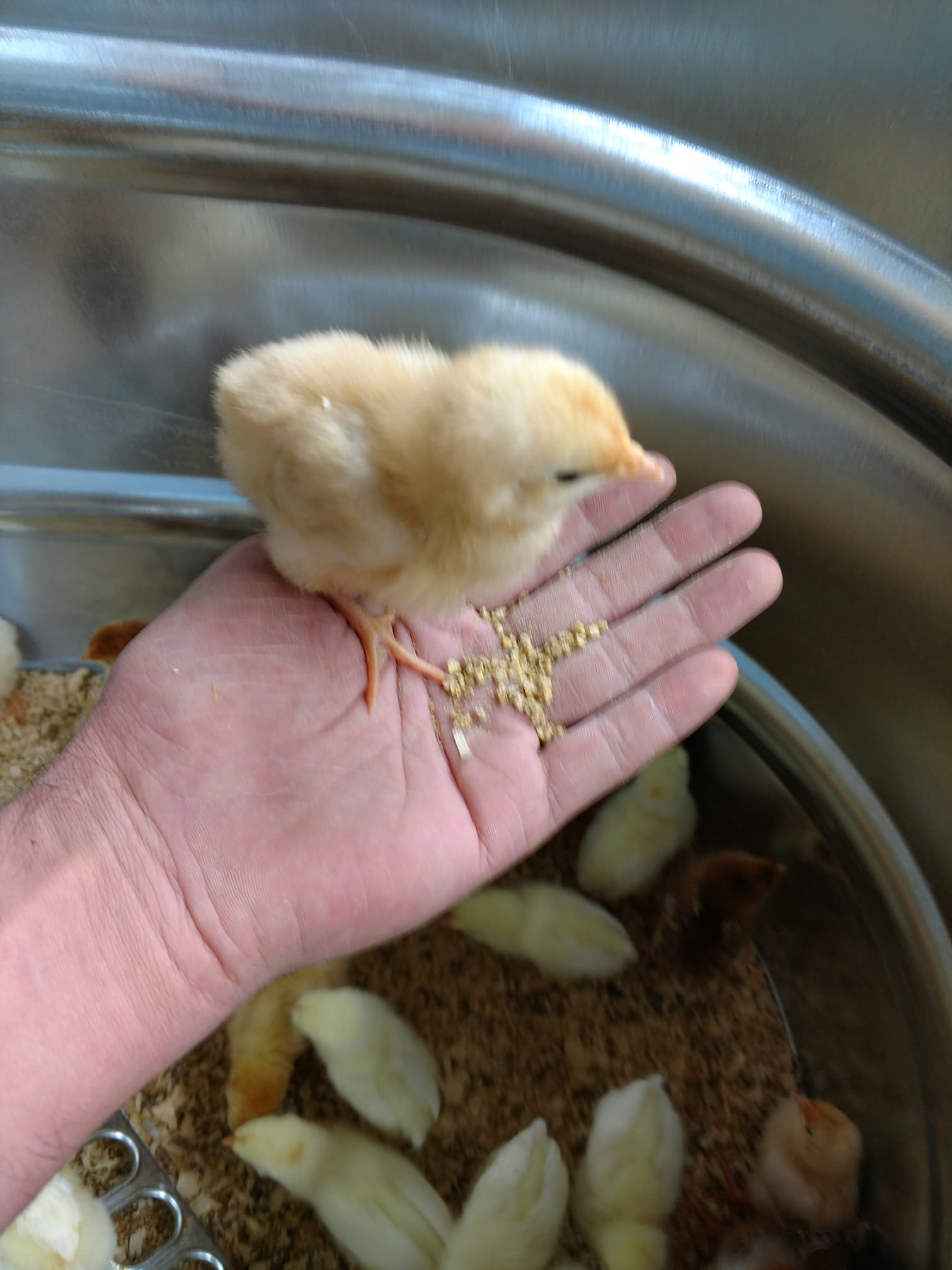
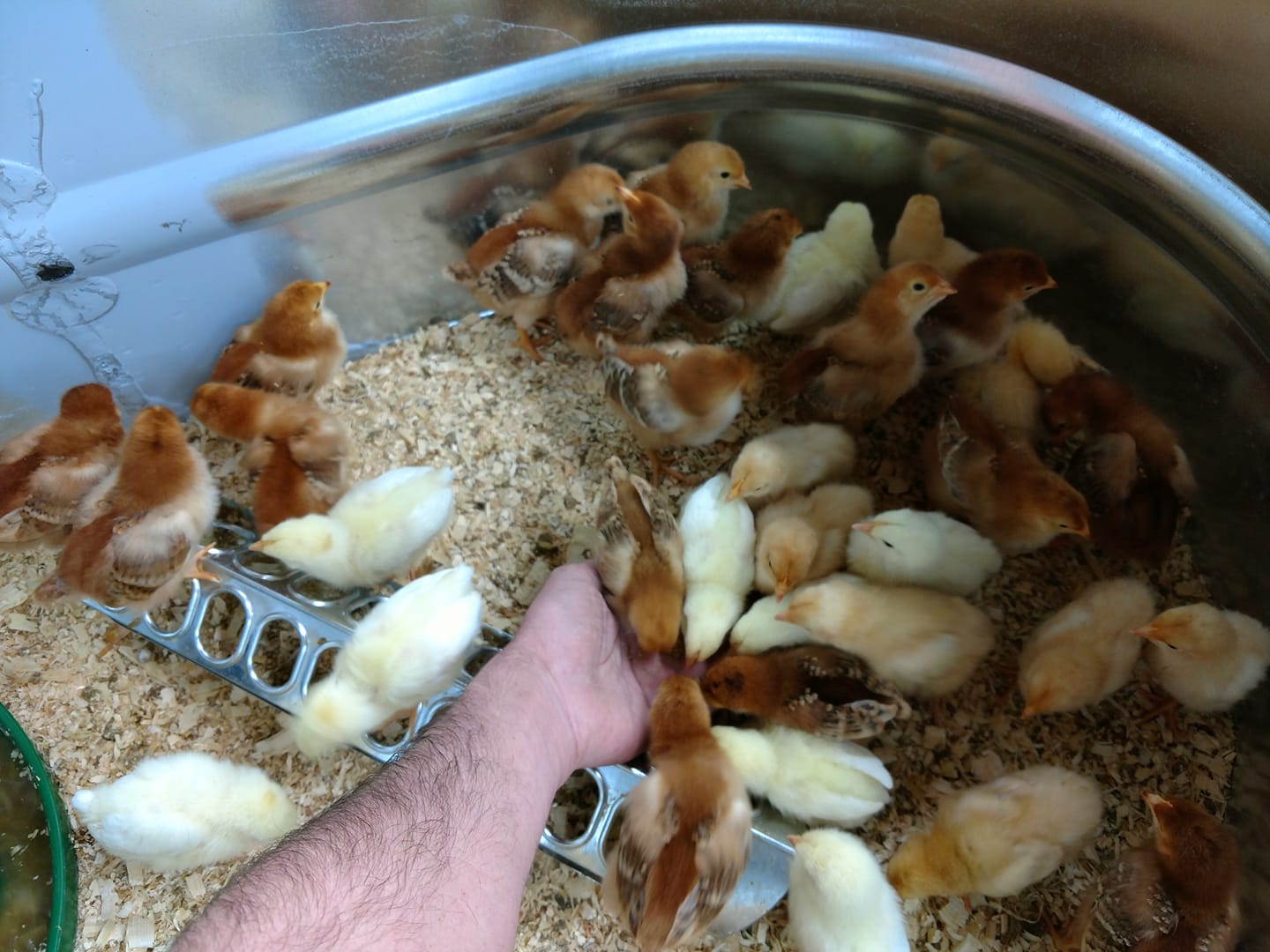
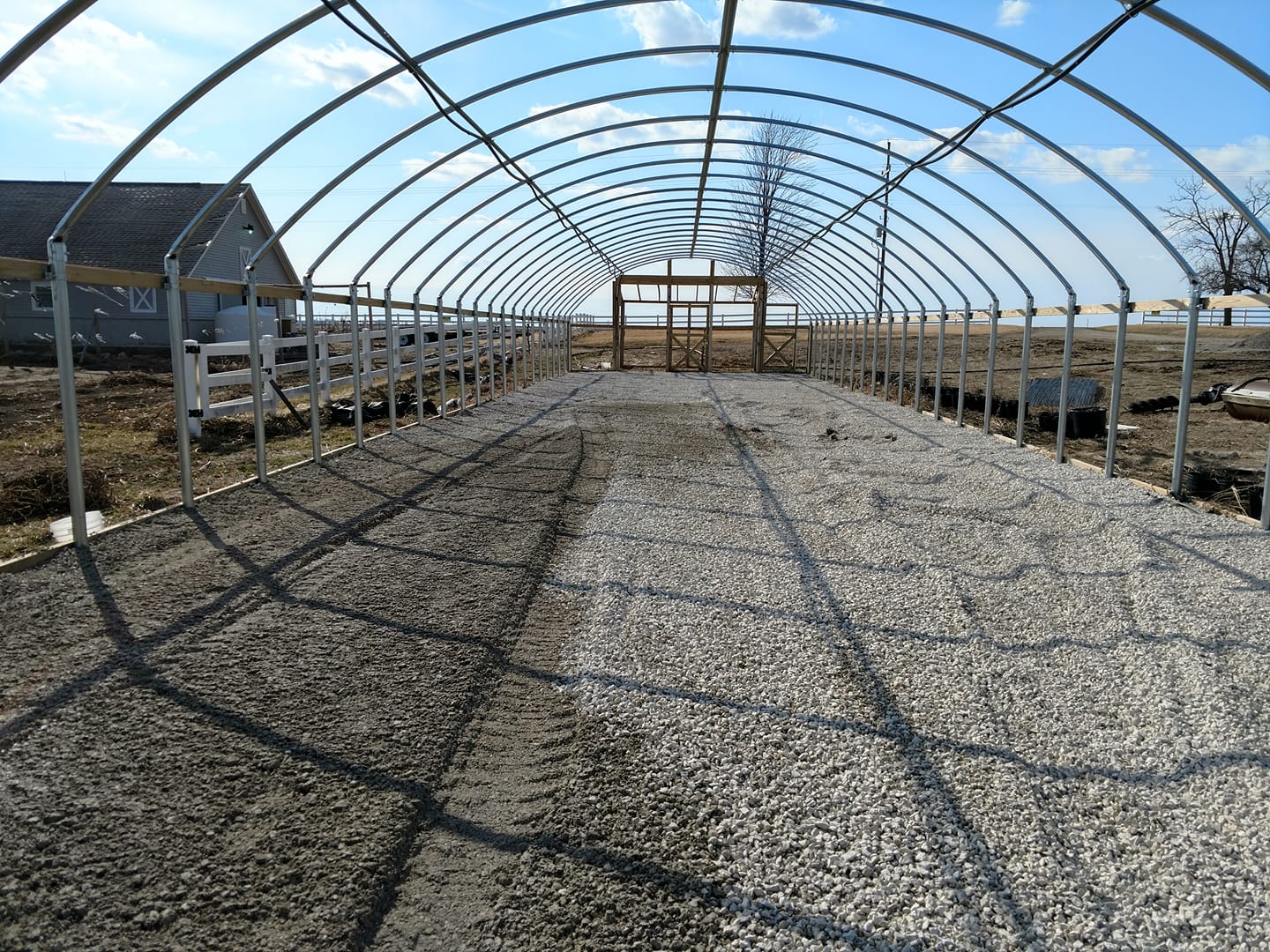
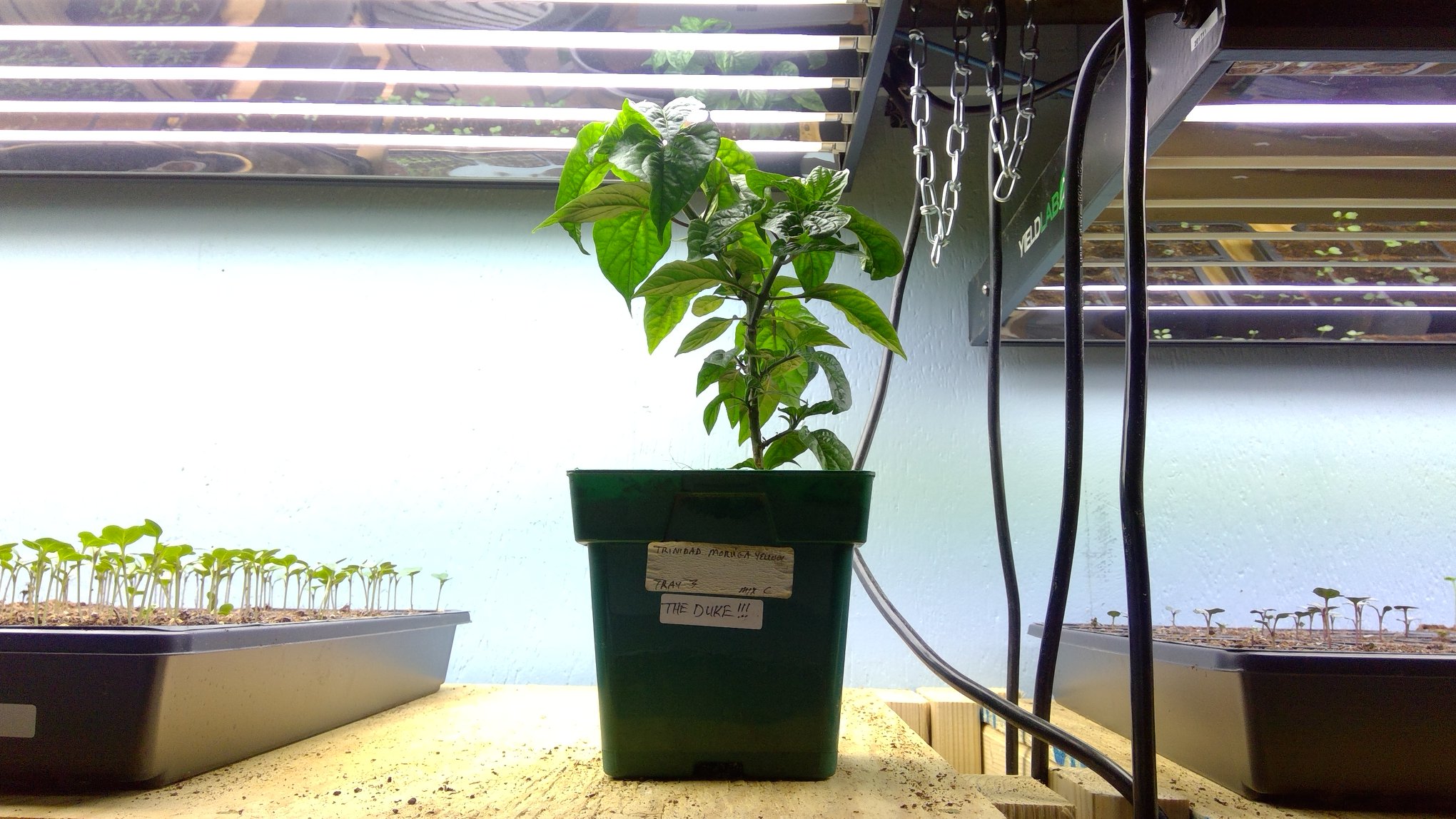
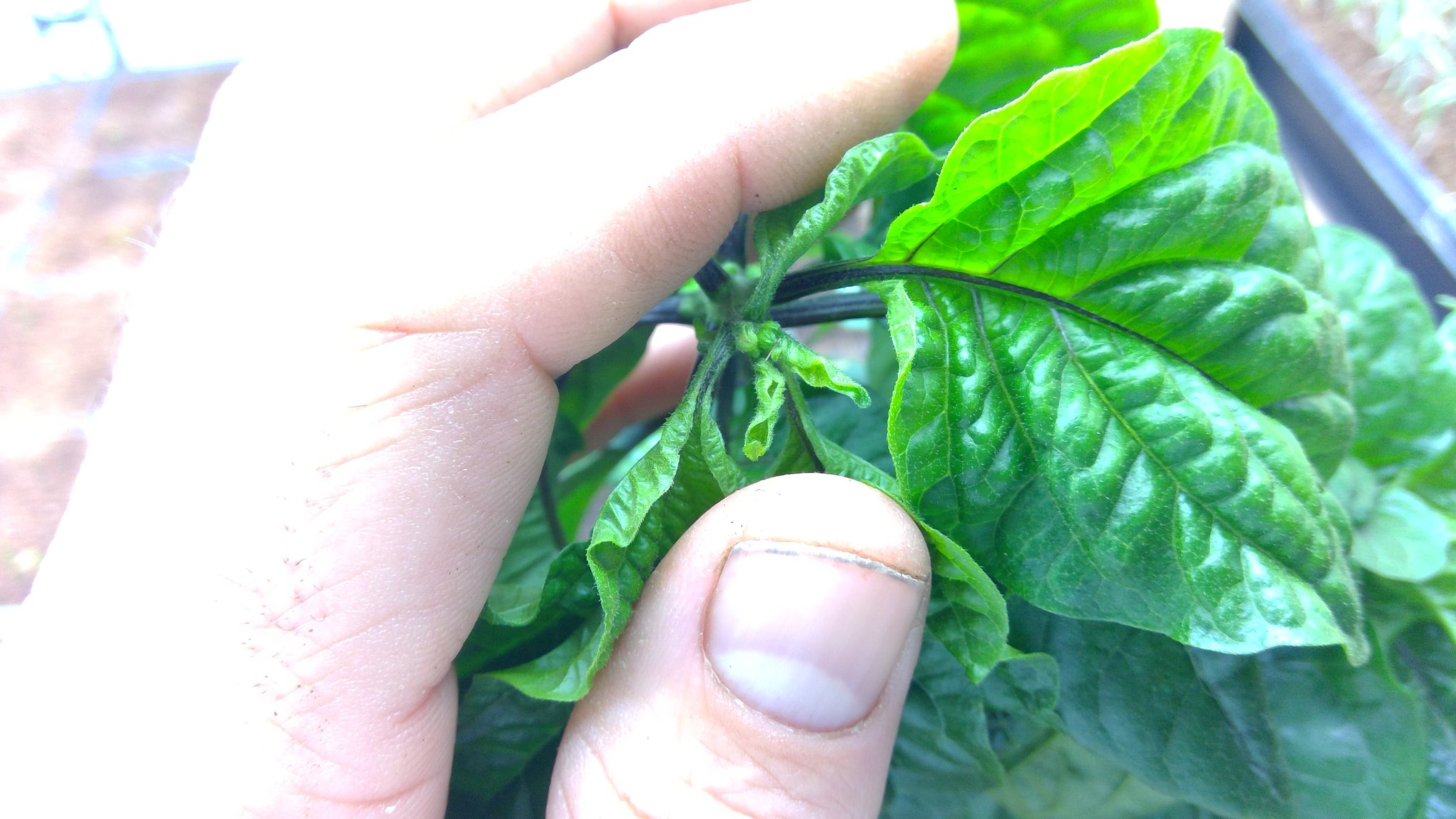

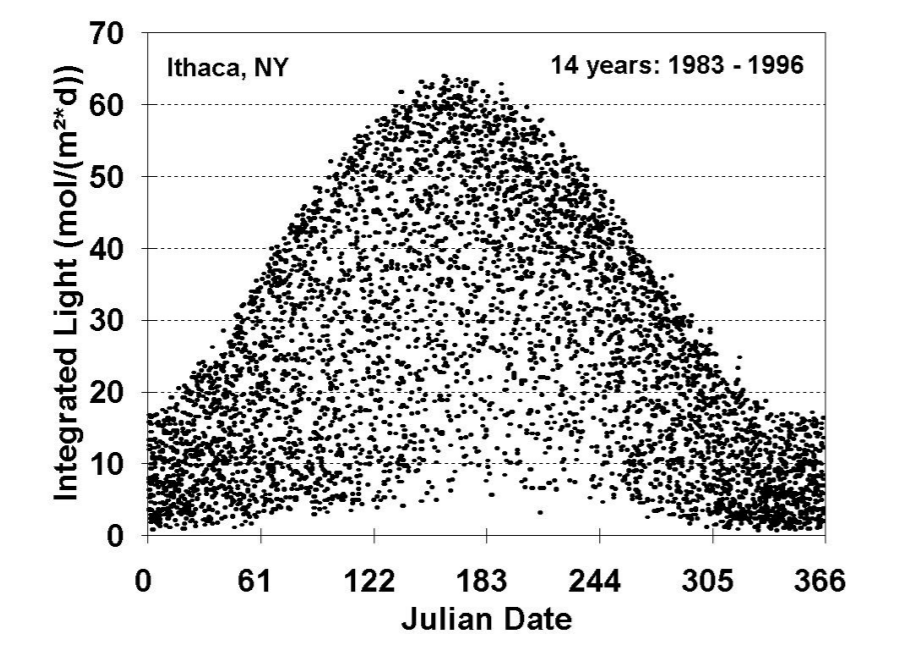

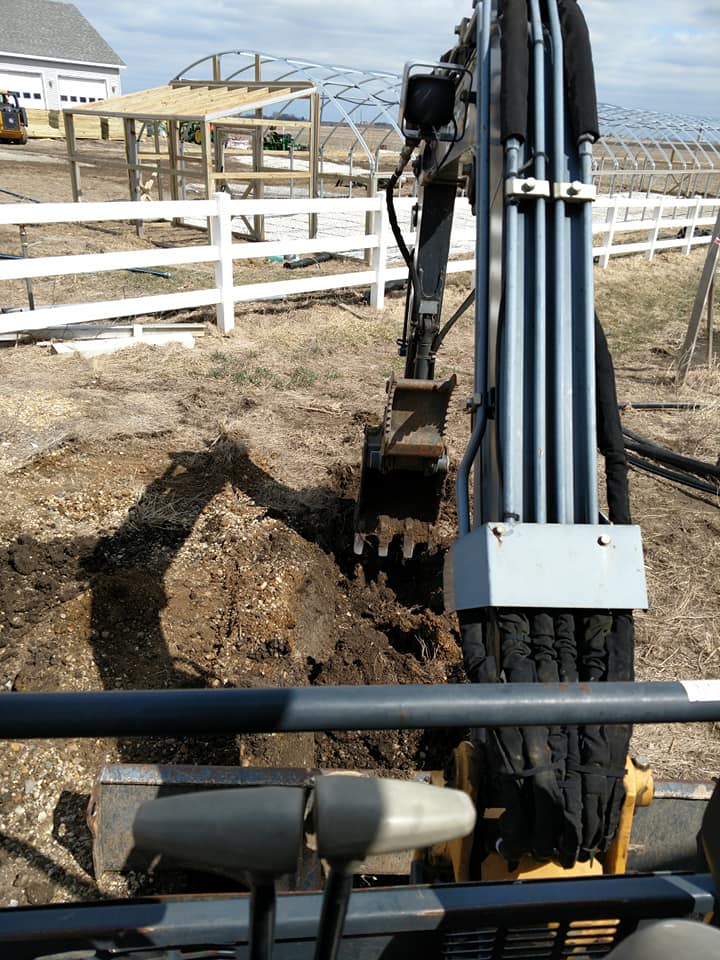
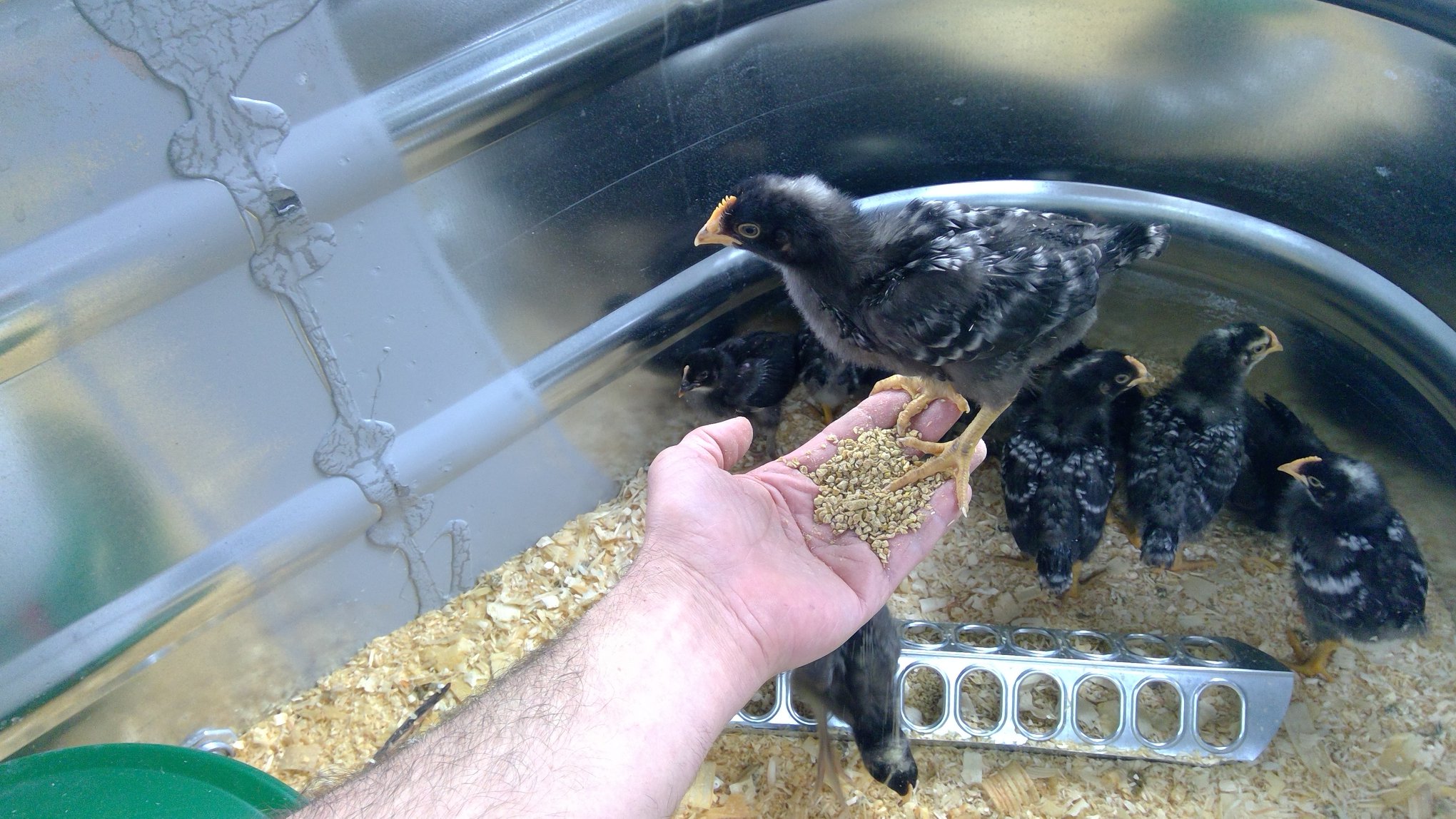
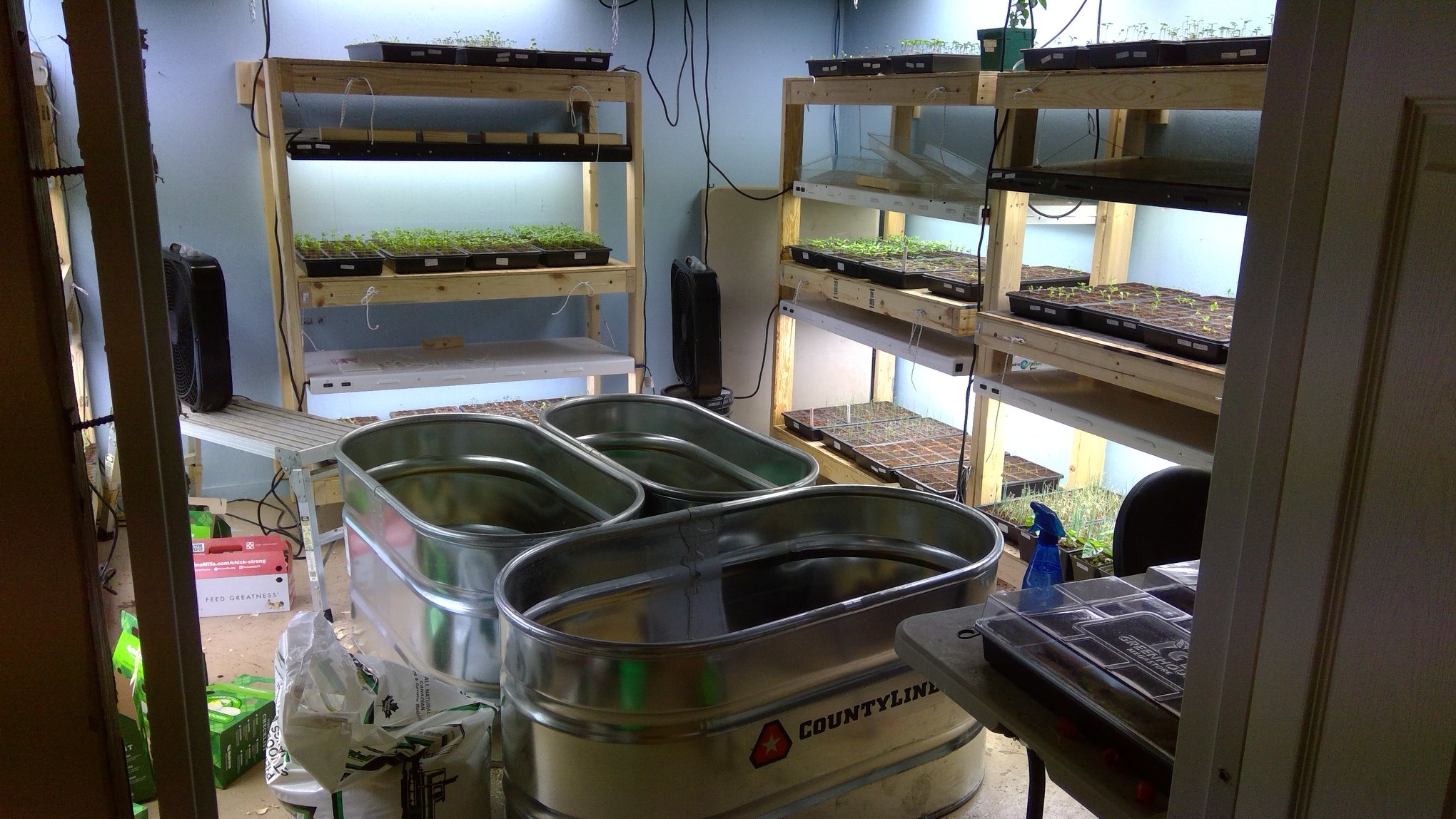
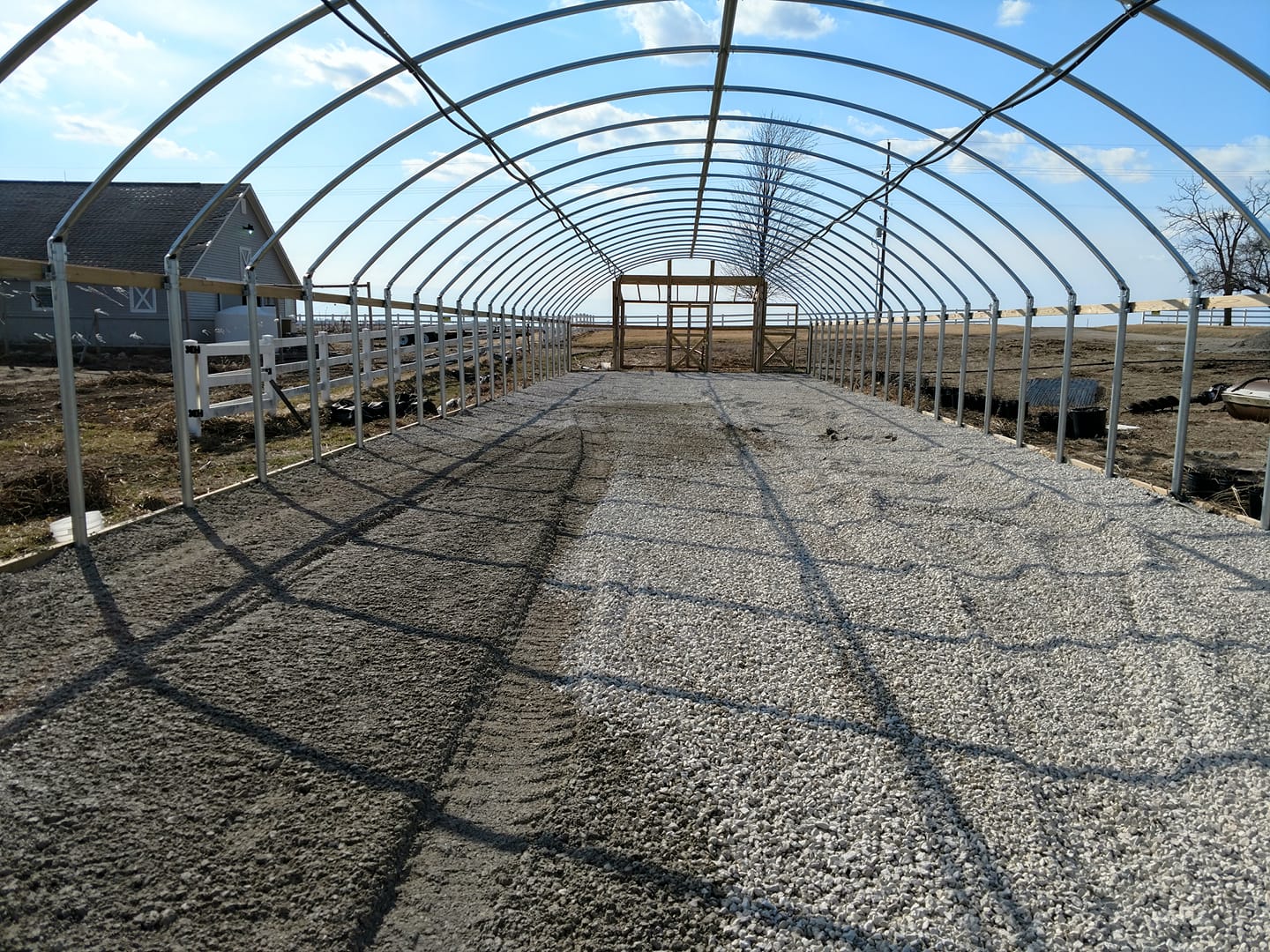

 Yes for May on, until then they can handle our sunshine.
Yes for May on, until then they can handle our sunshine. 
